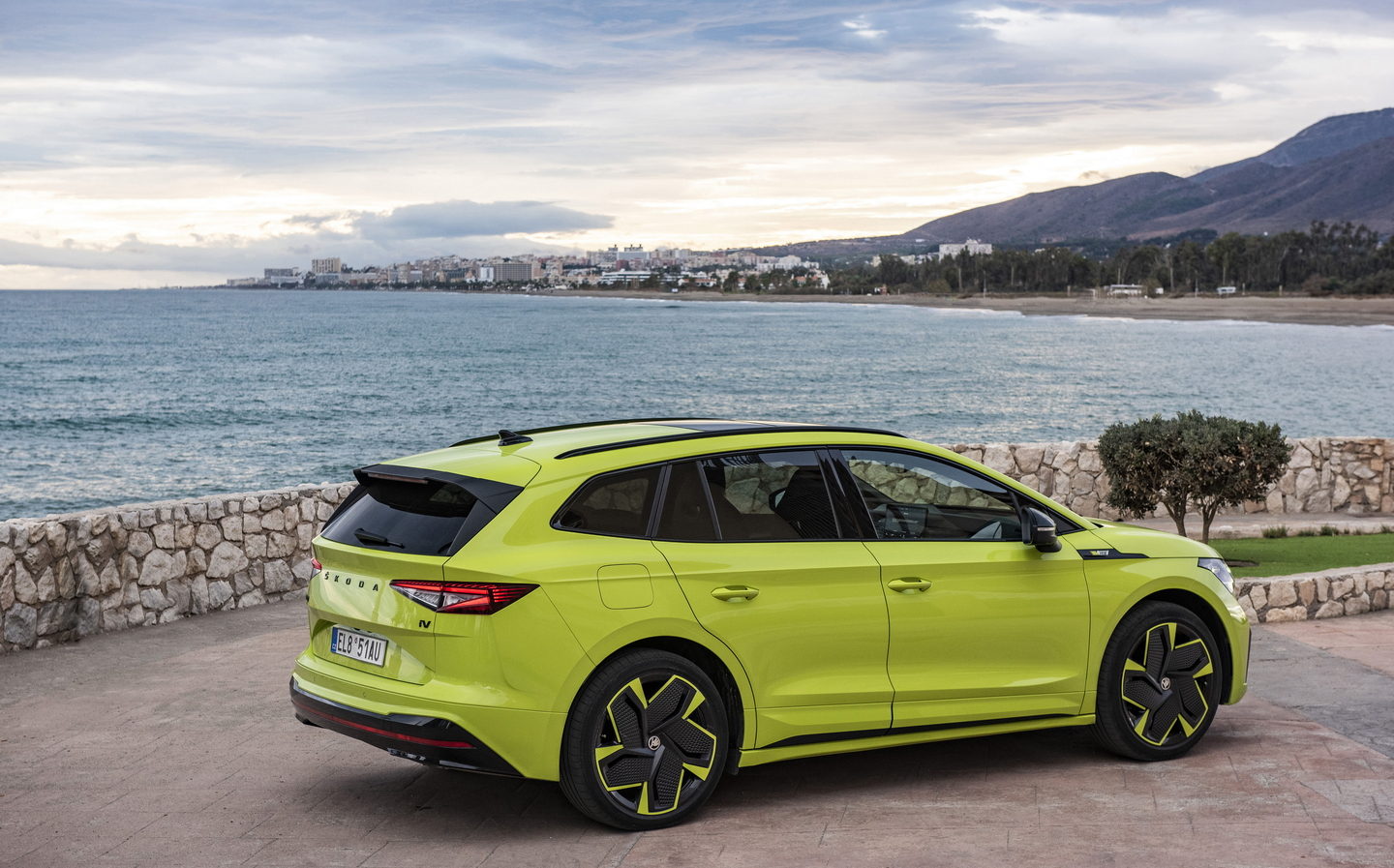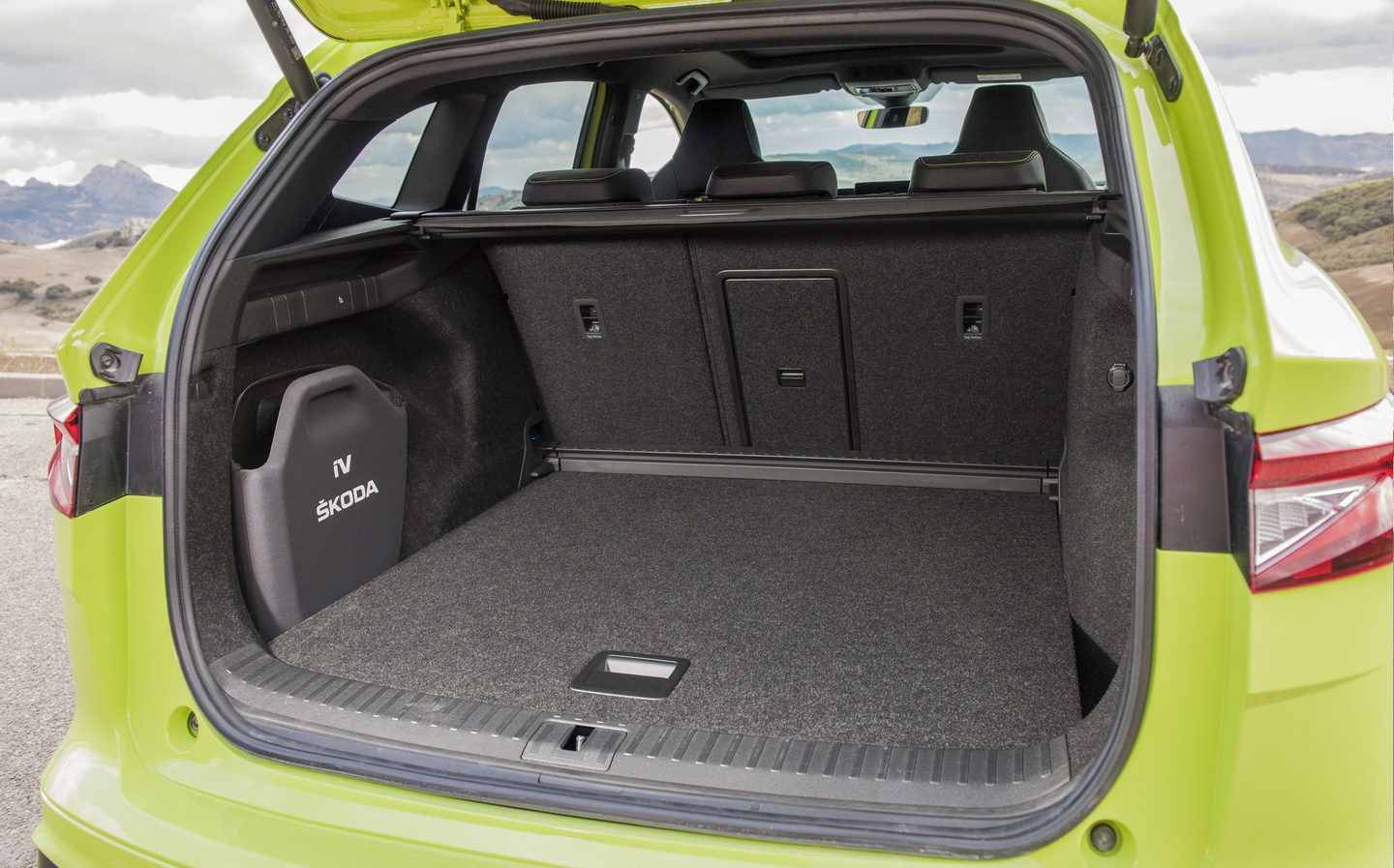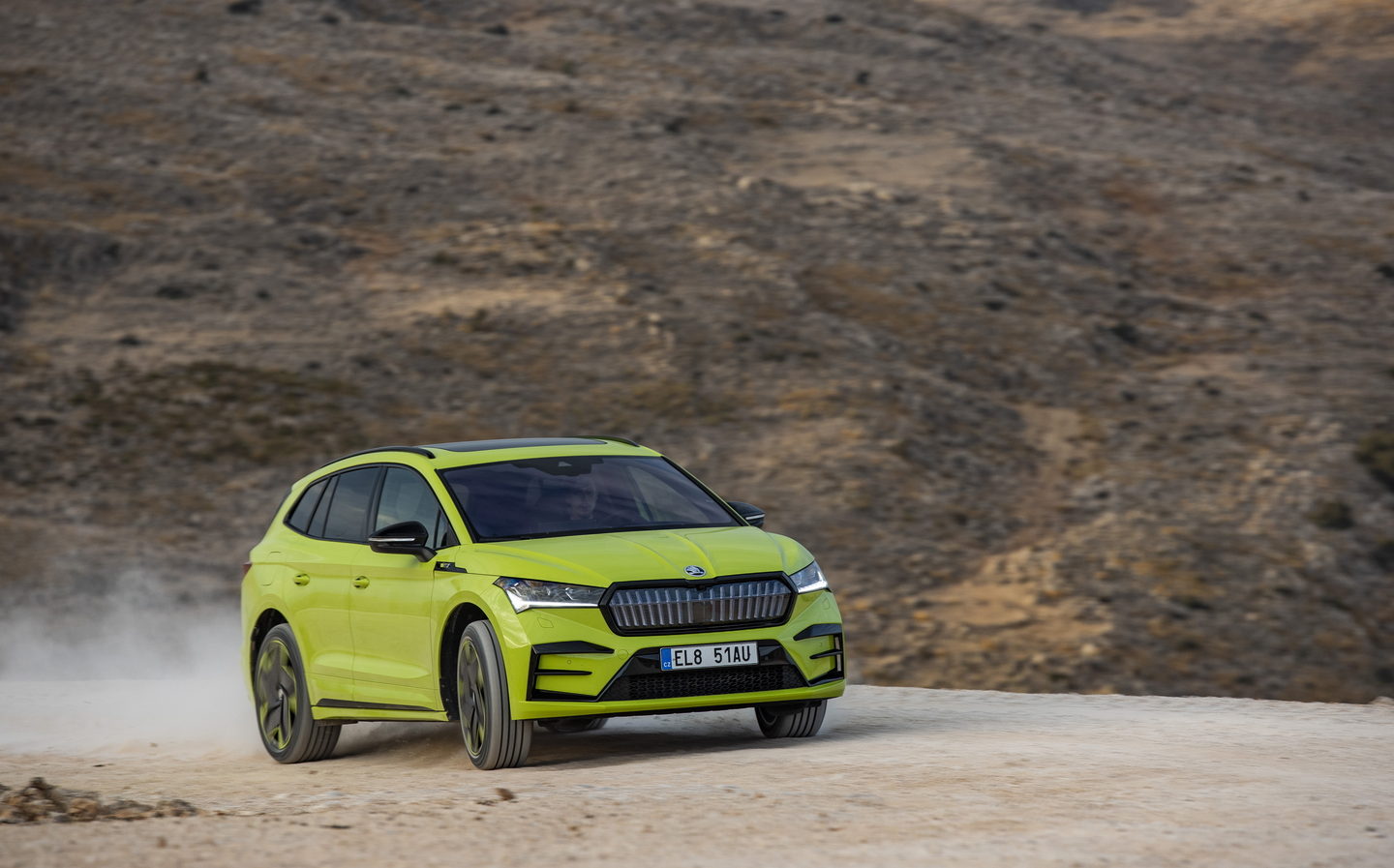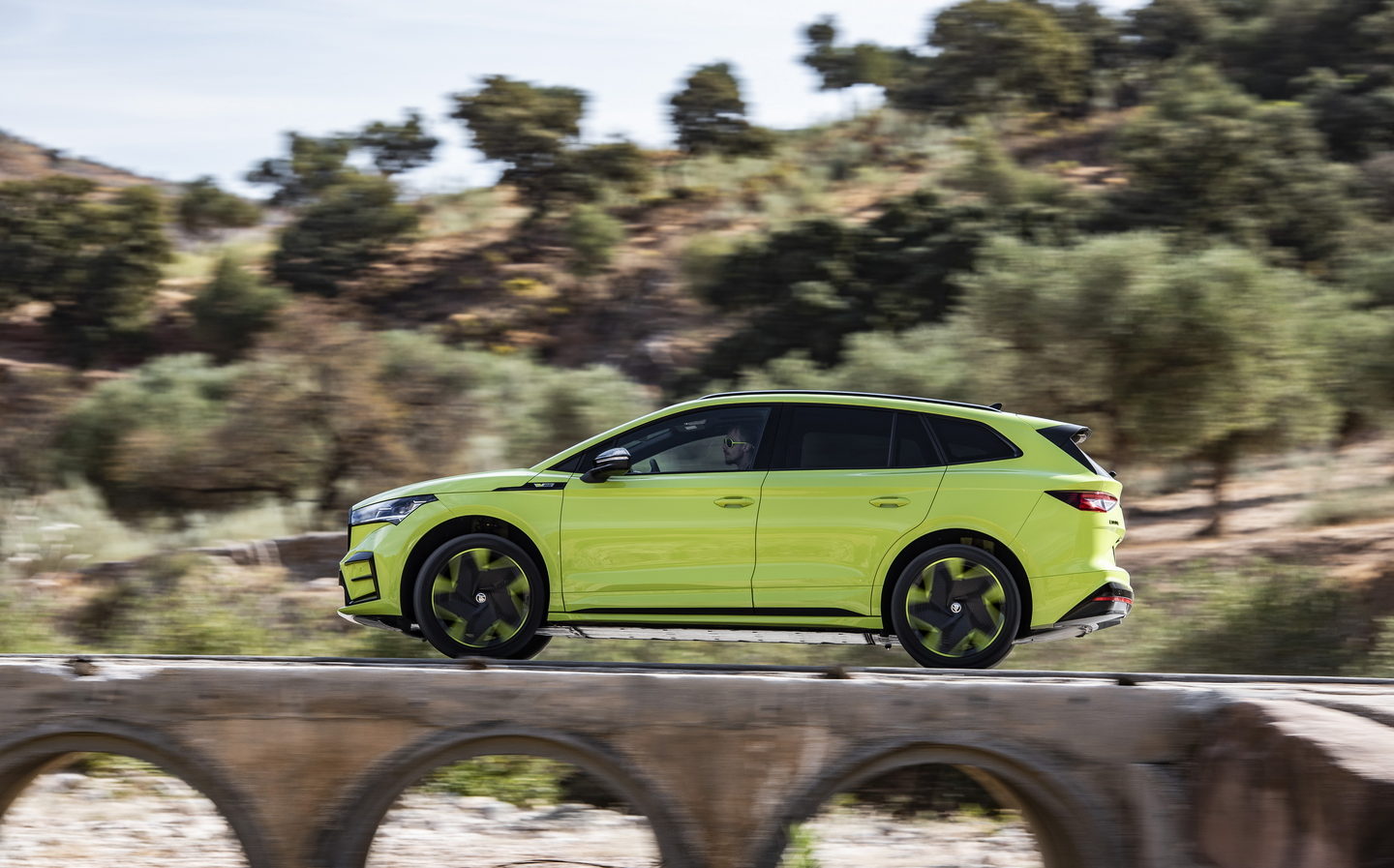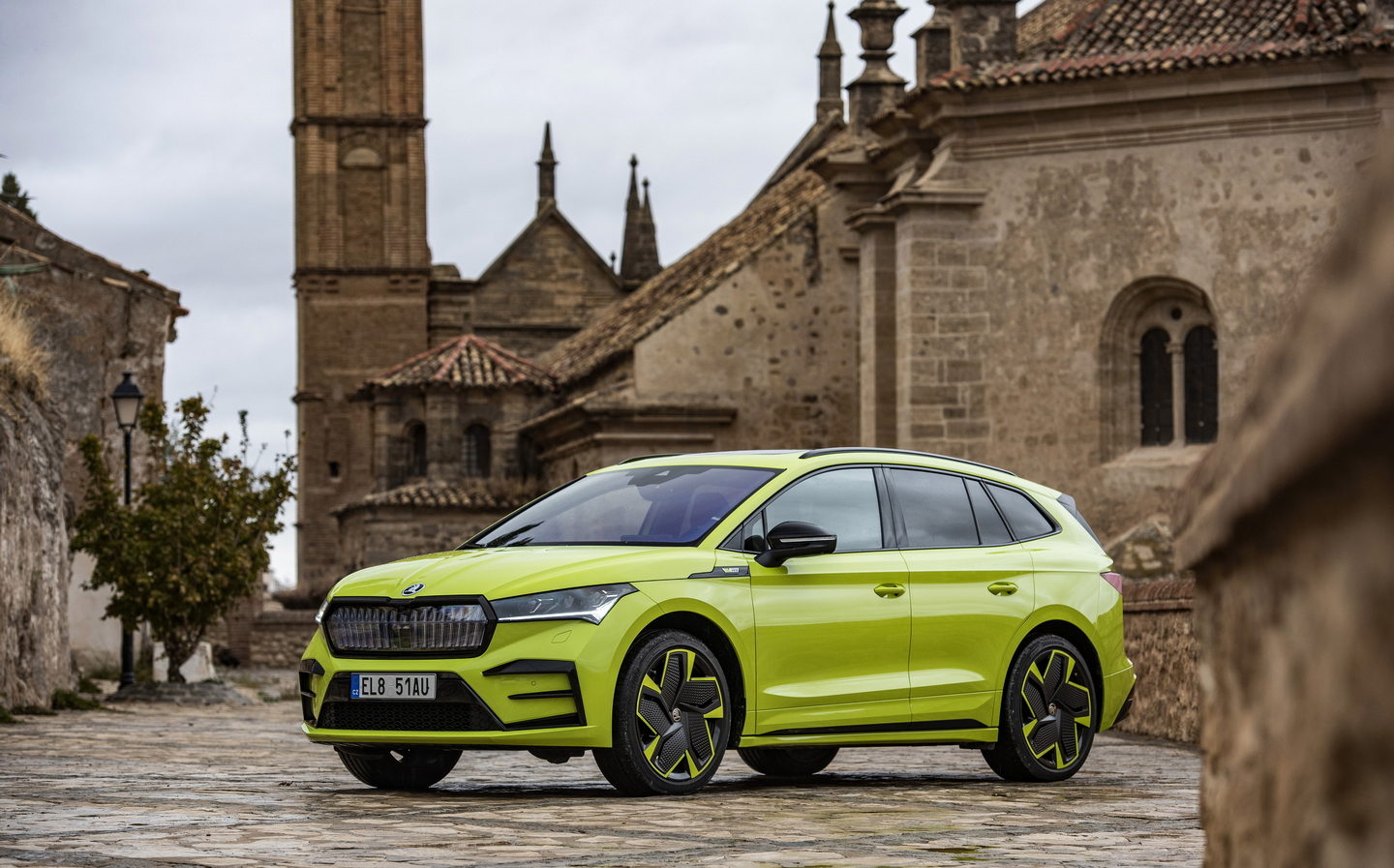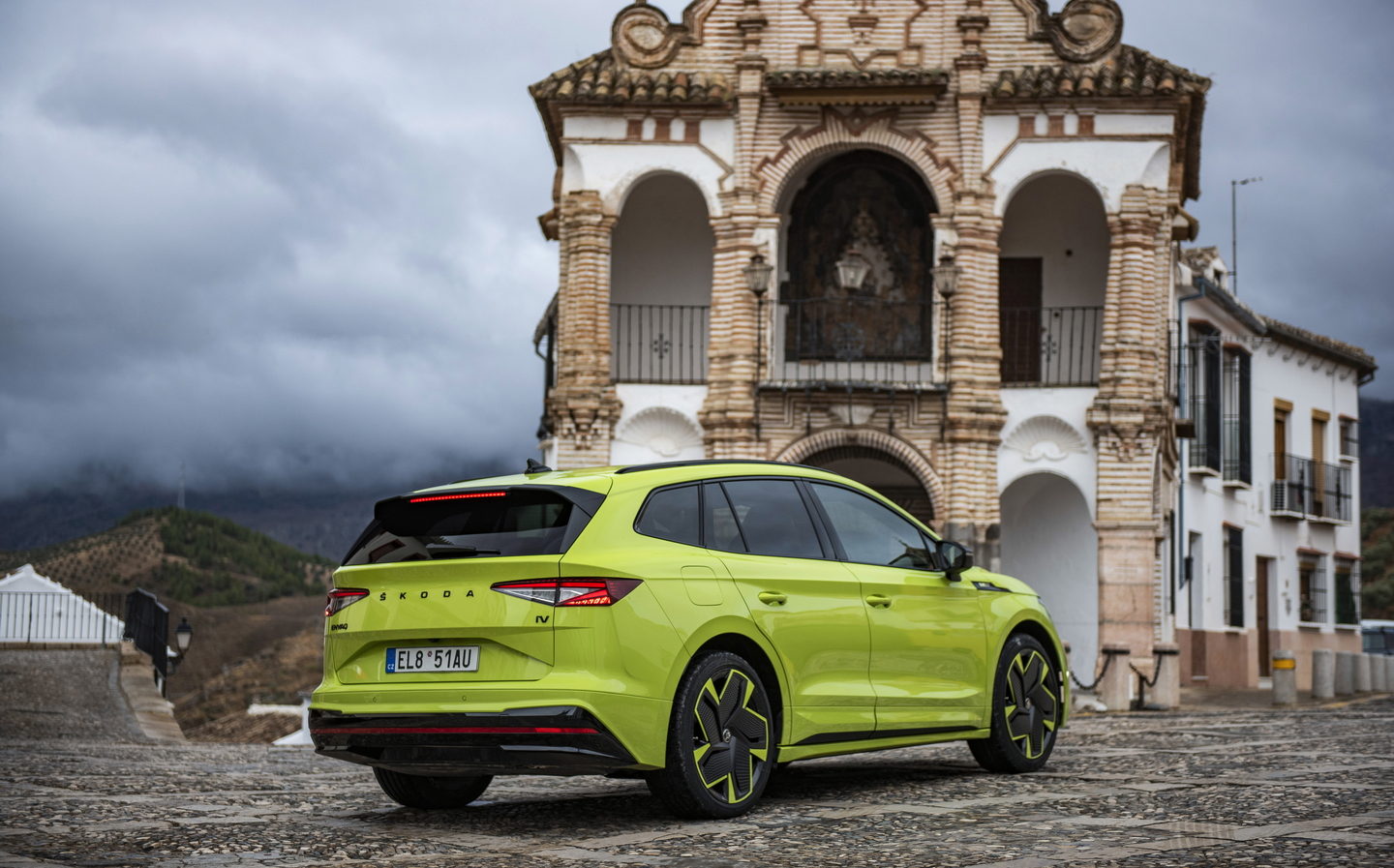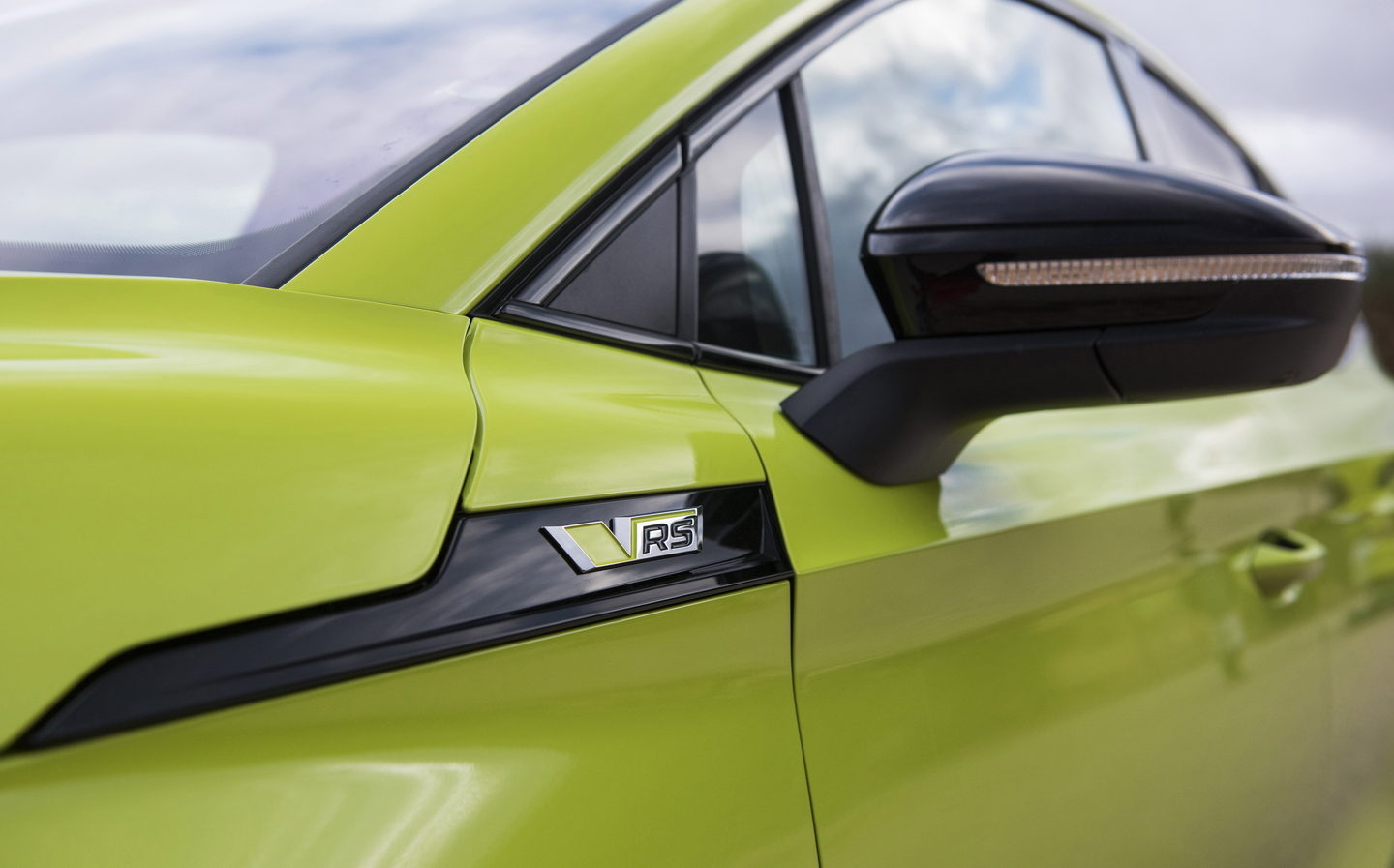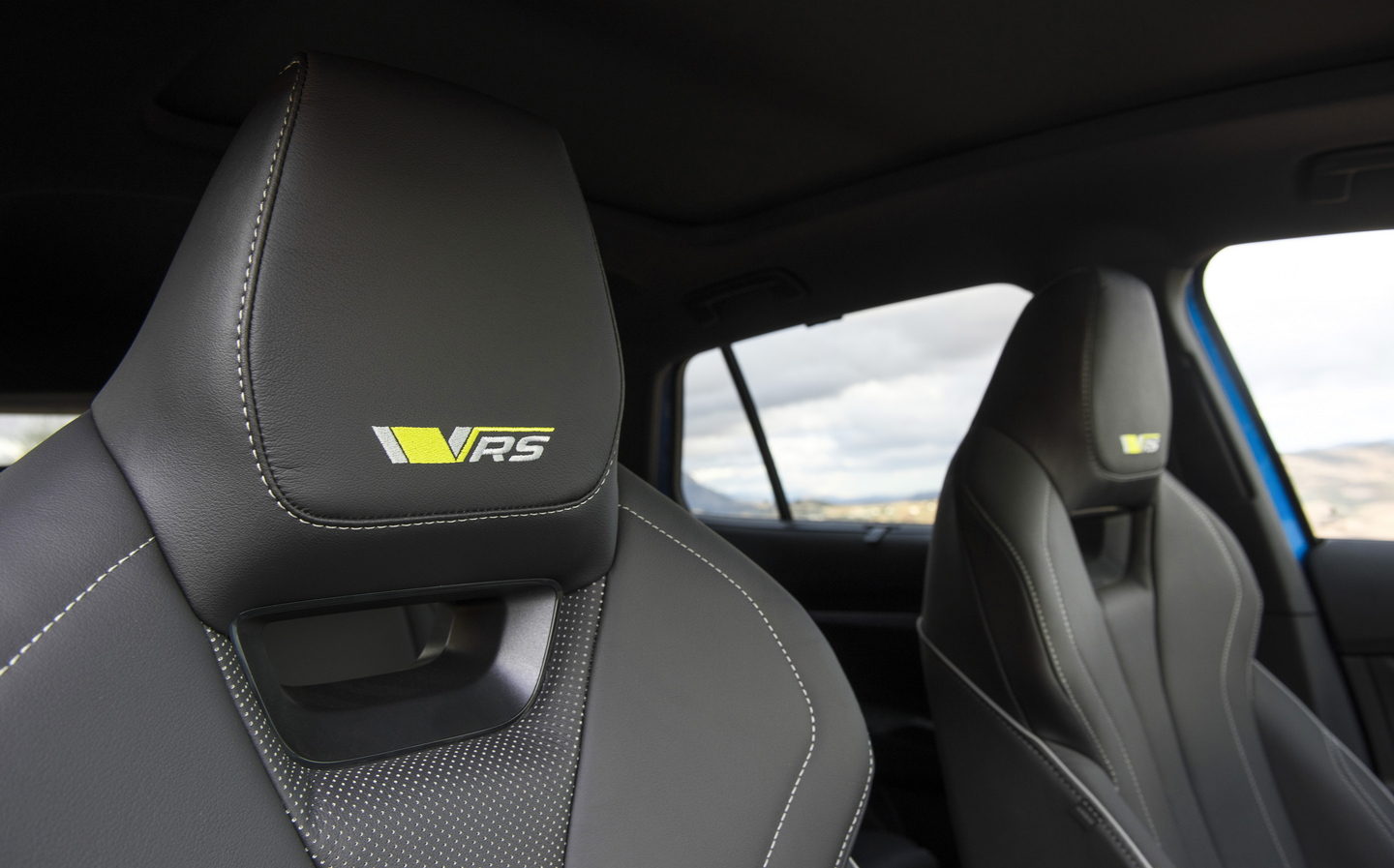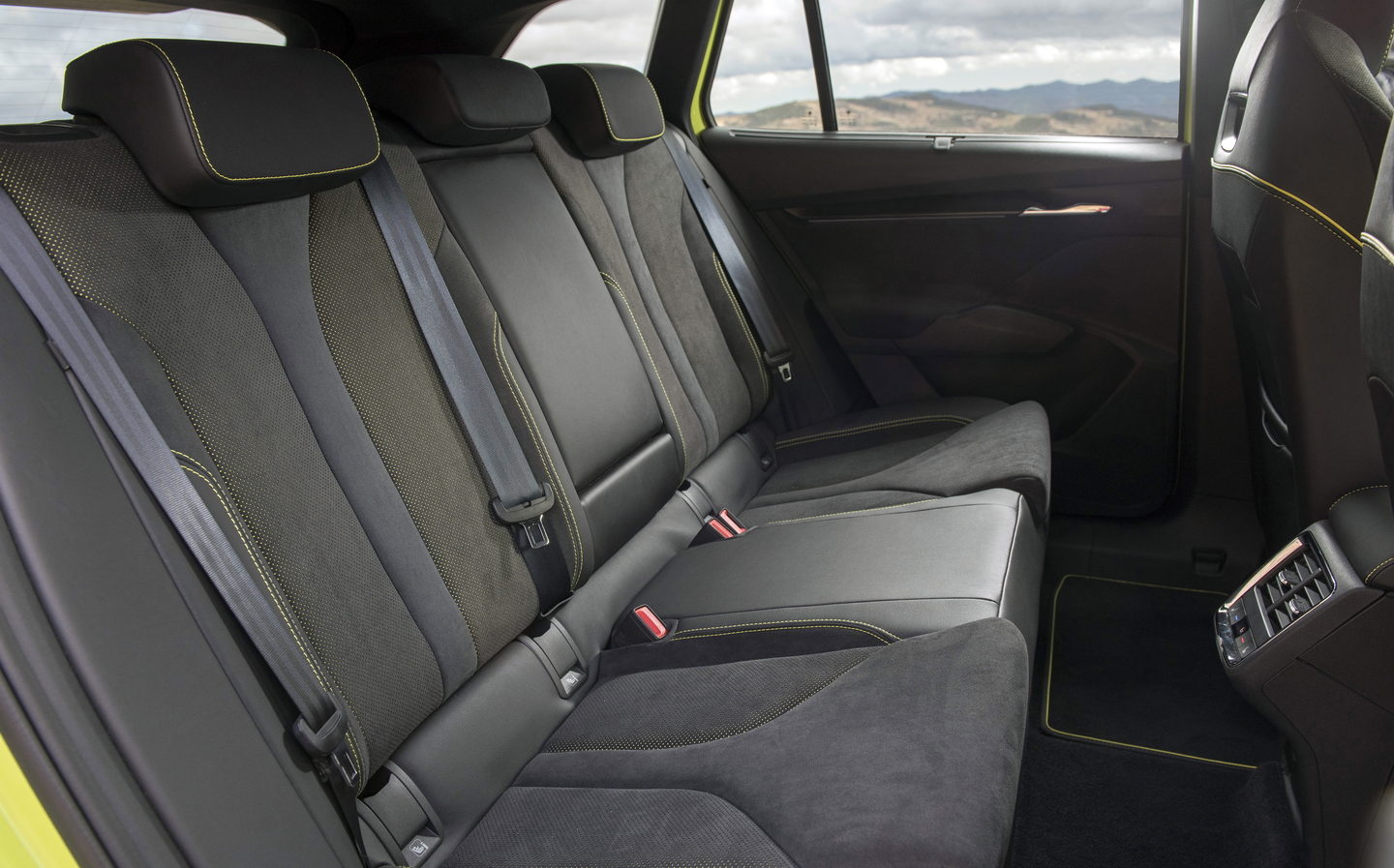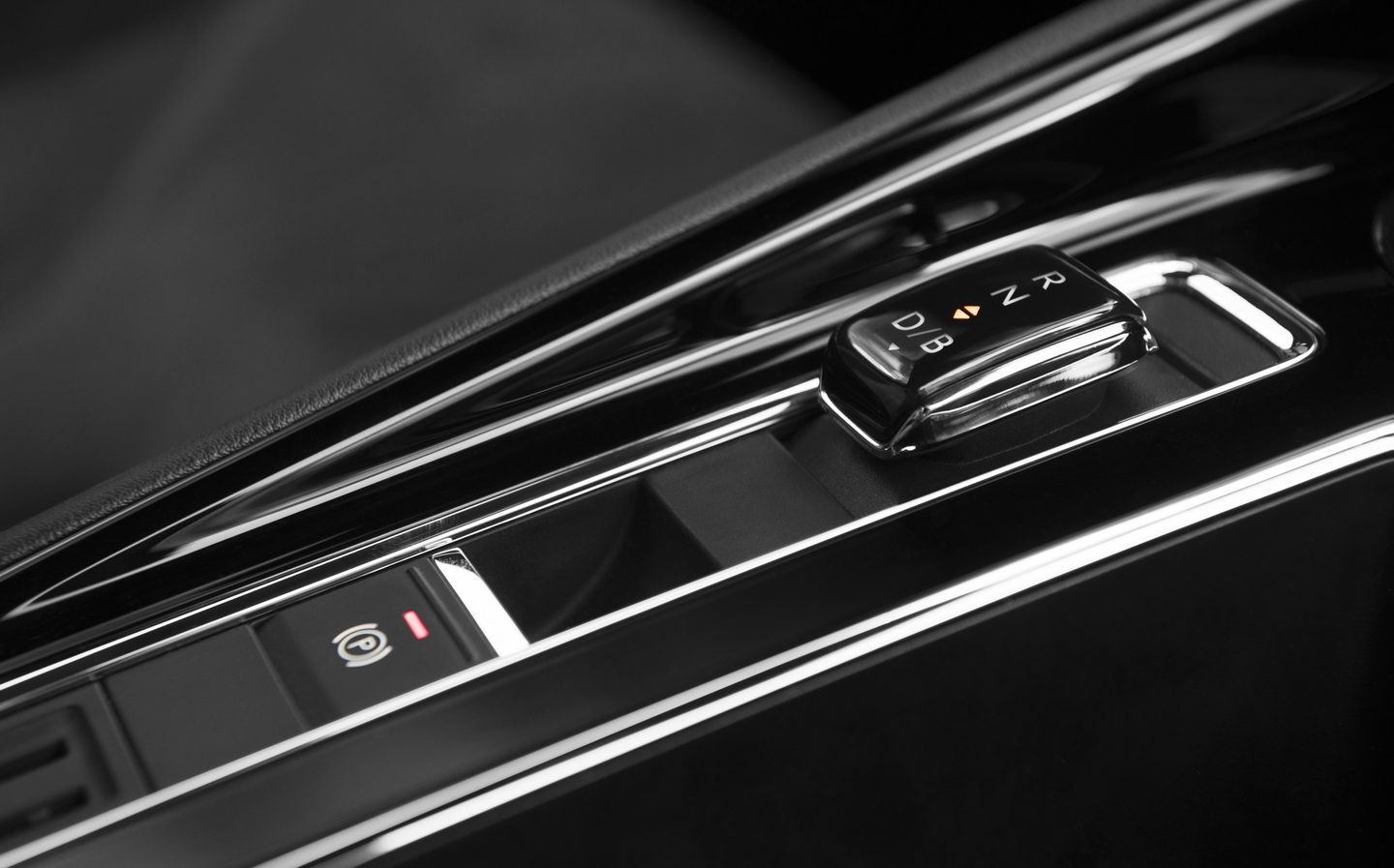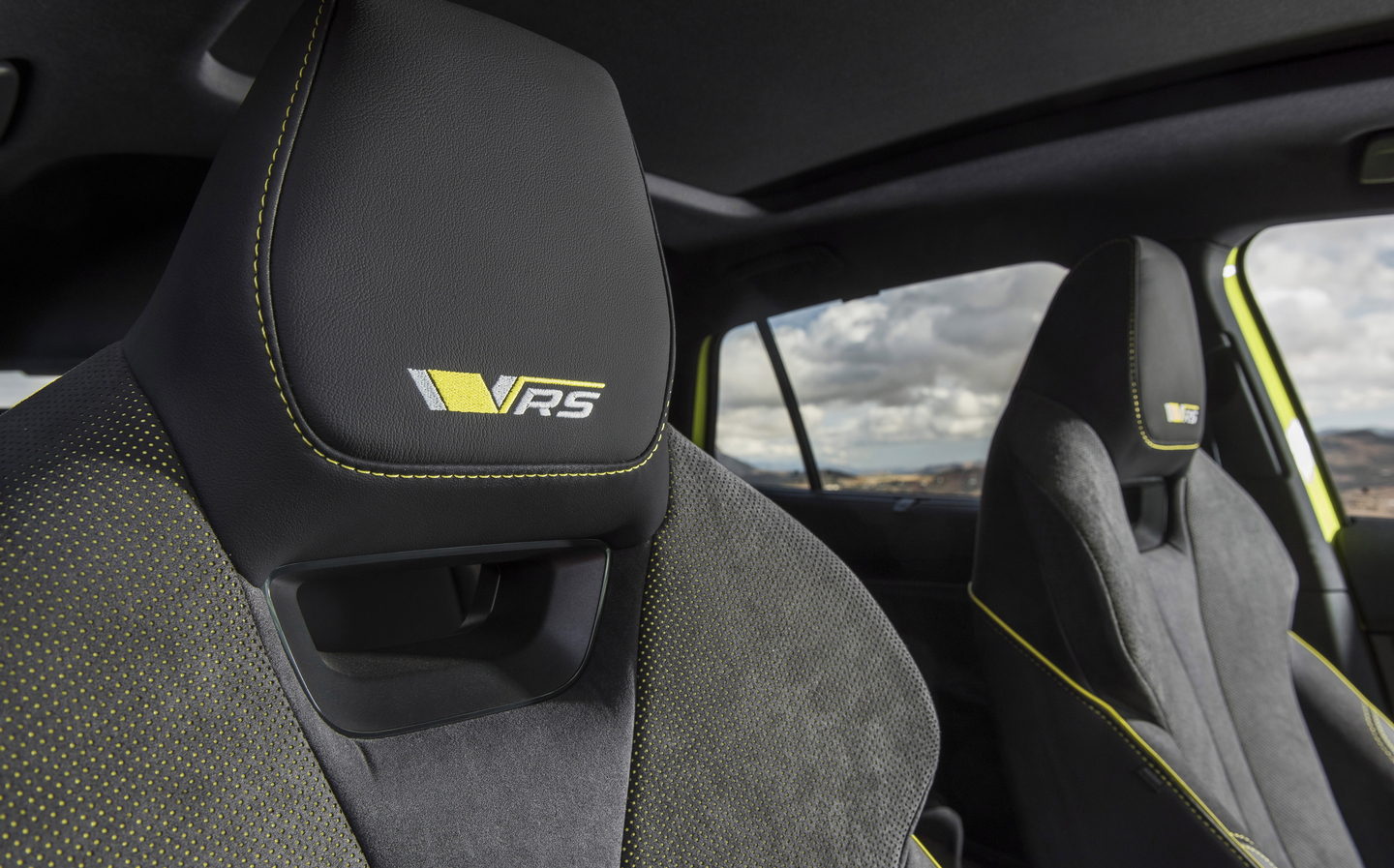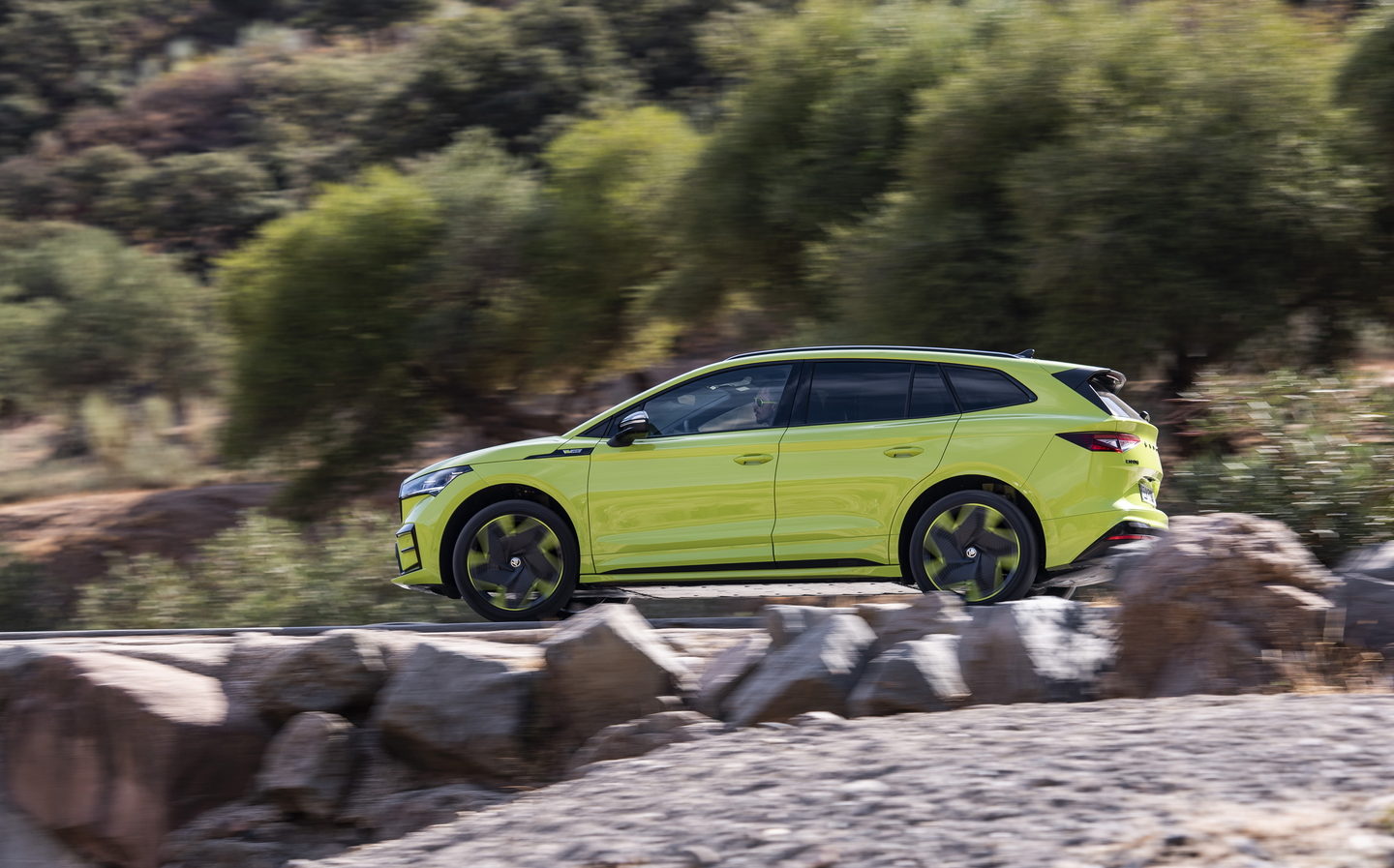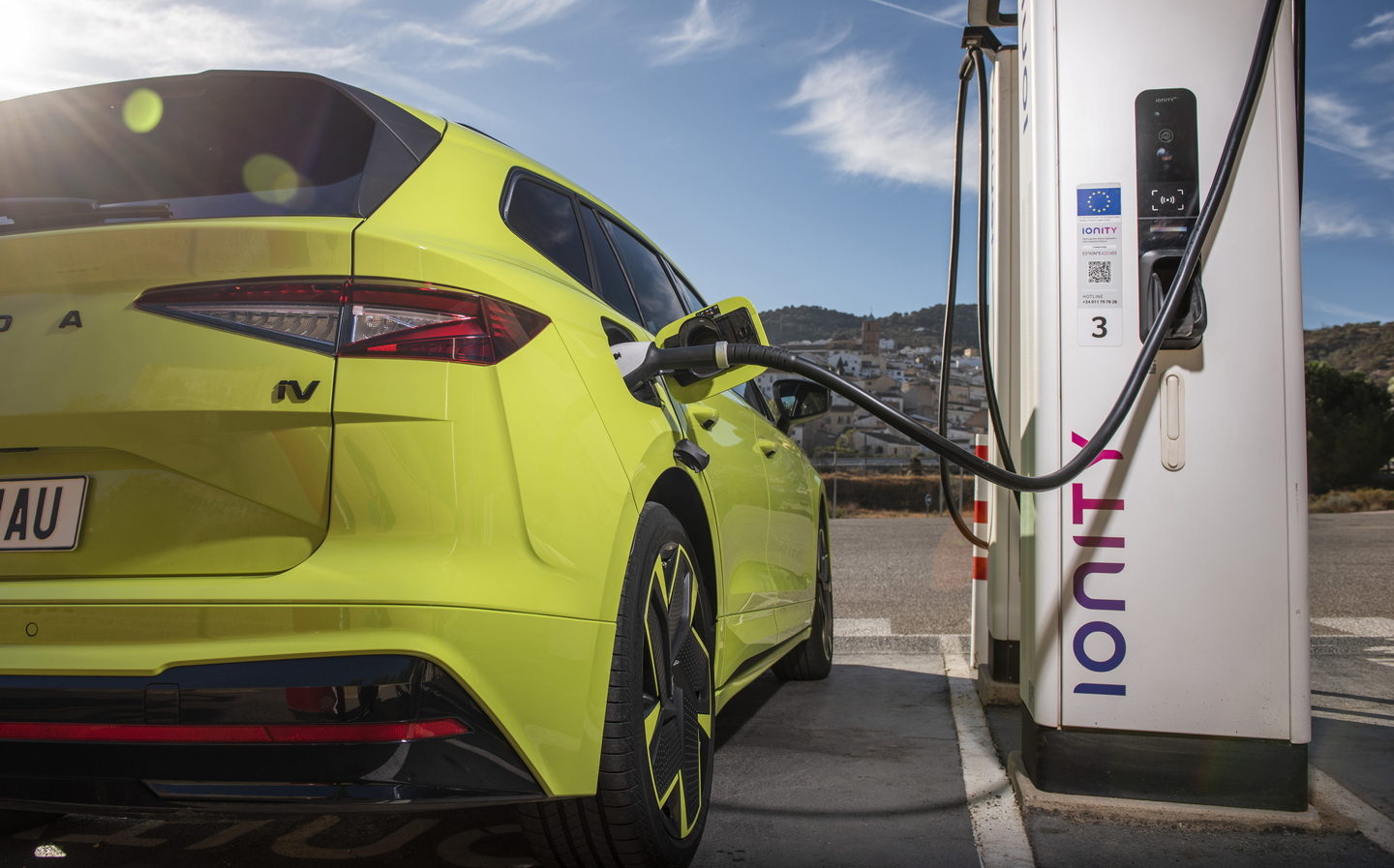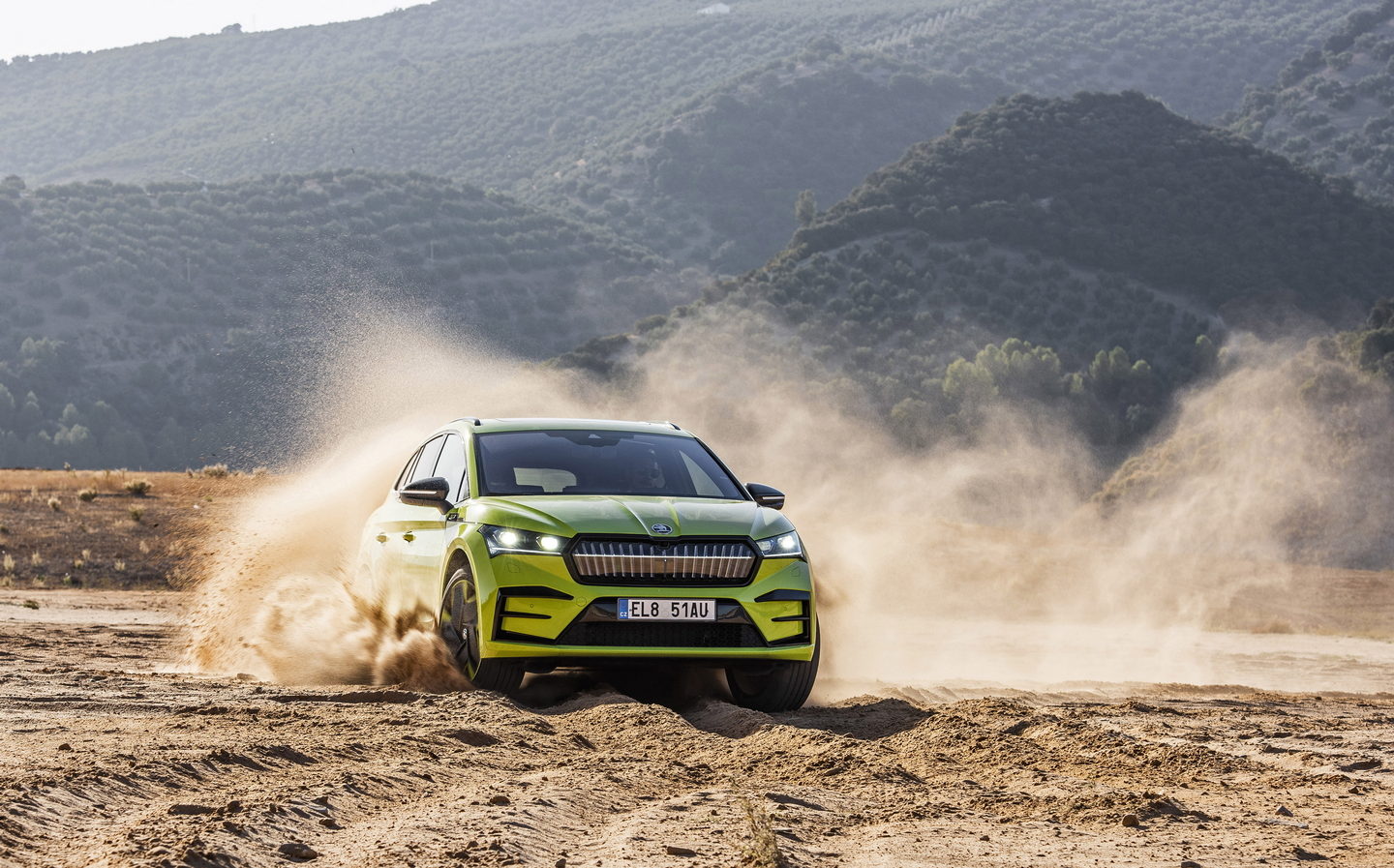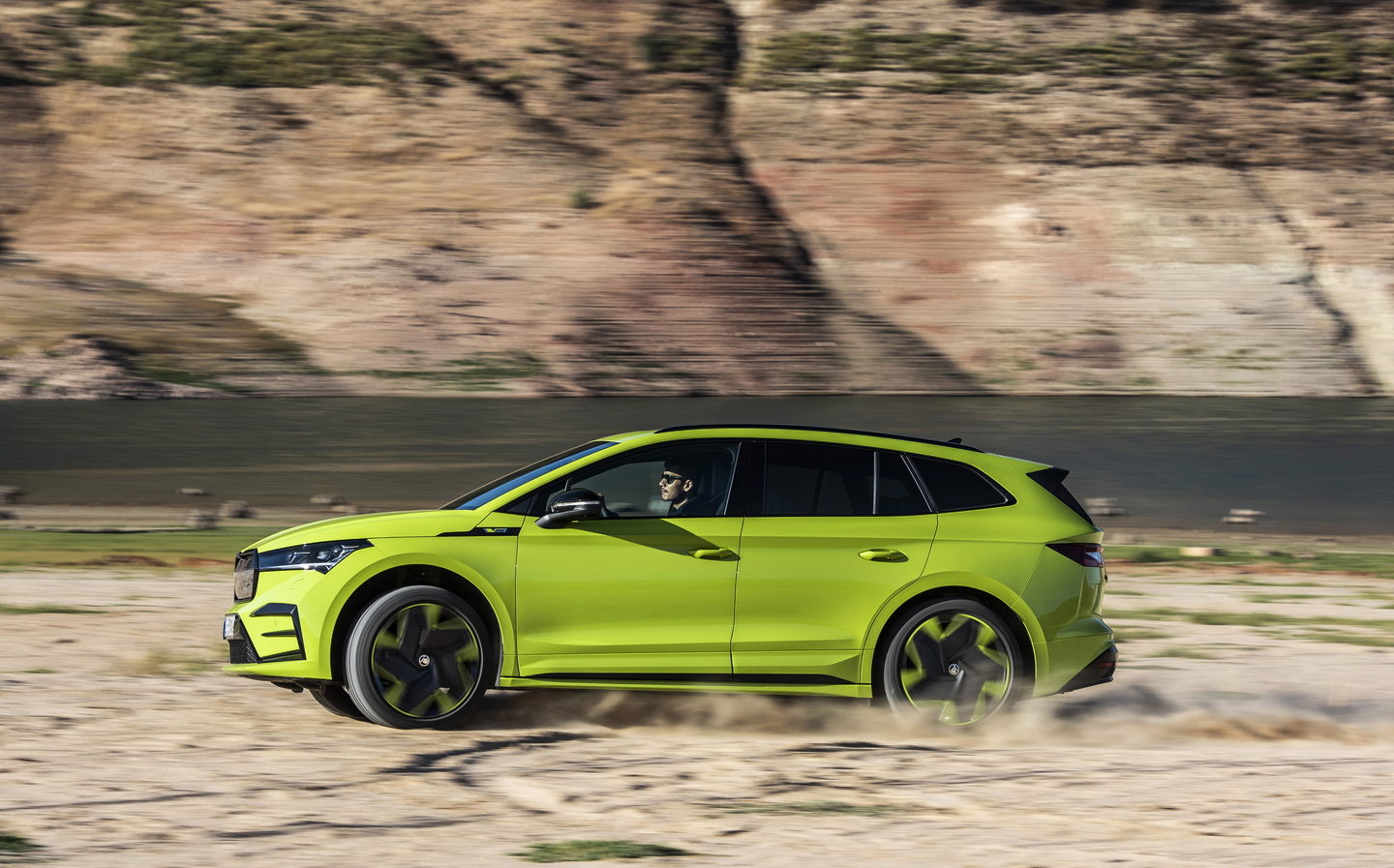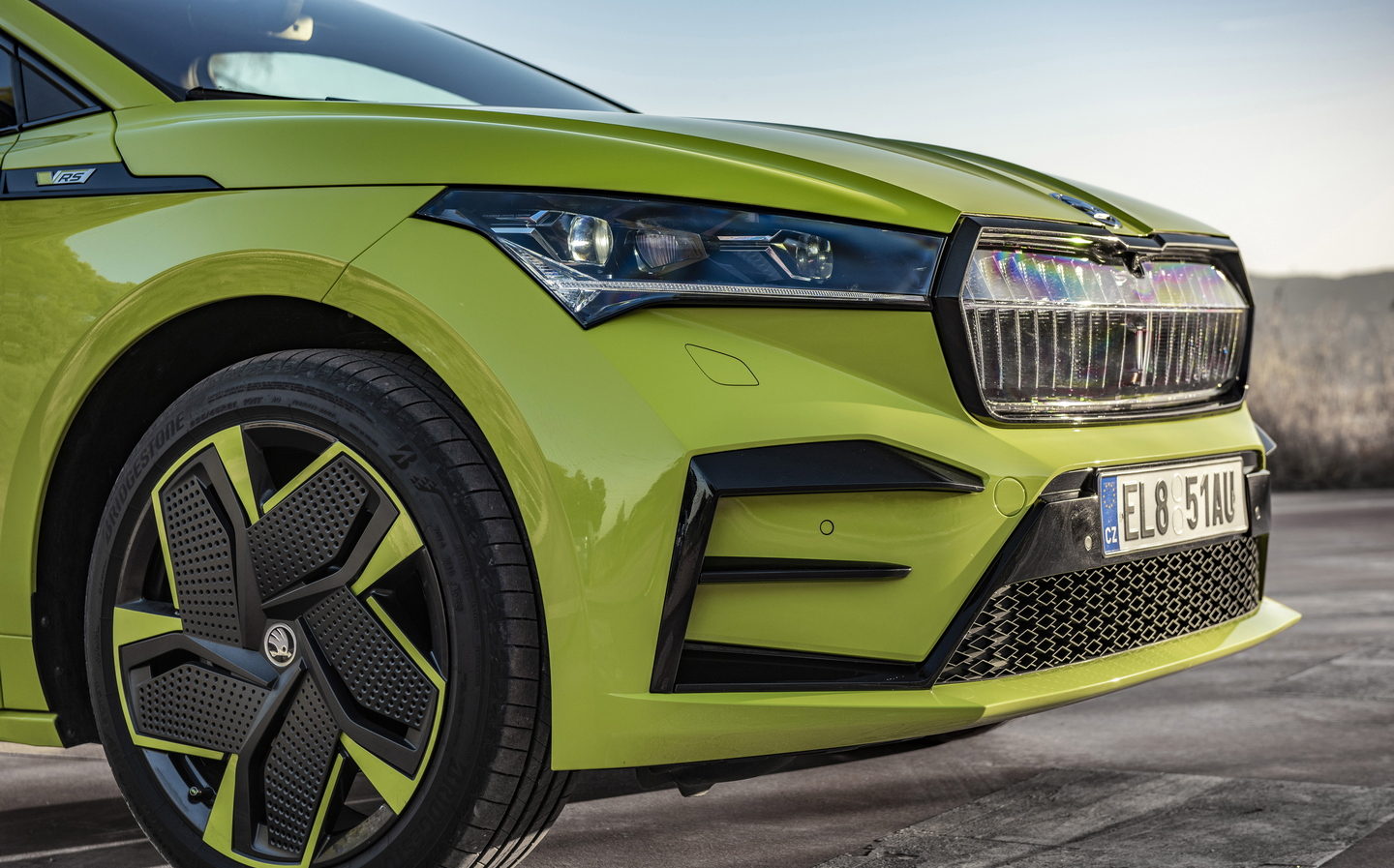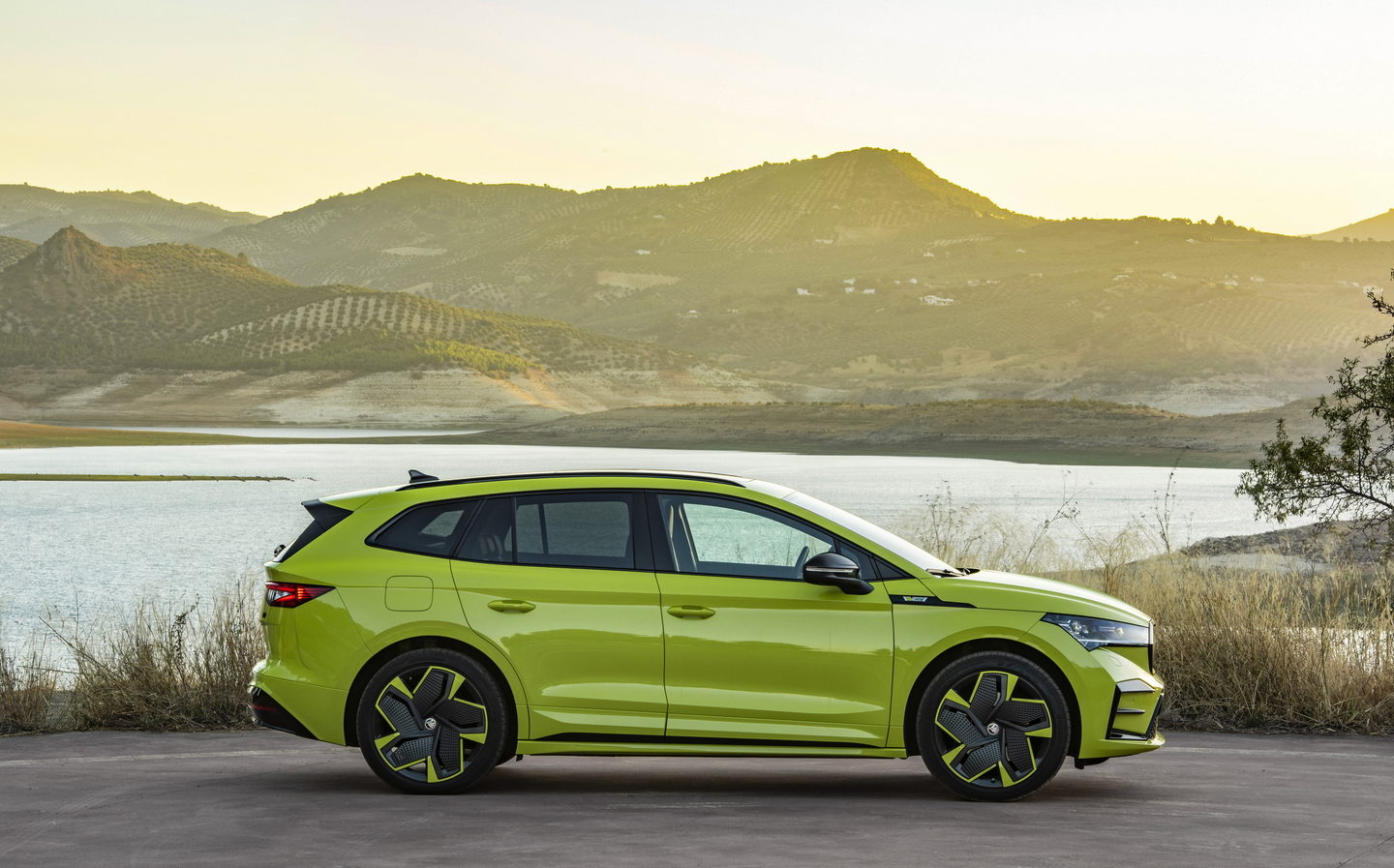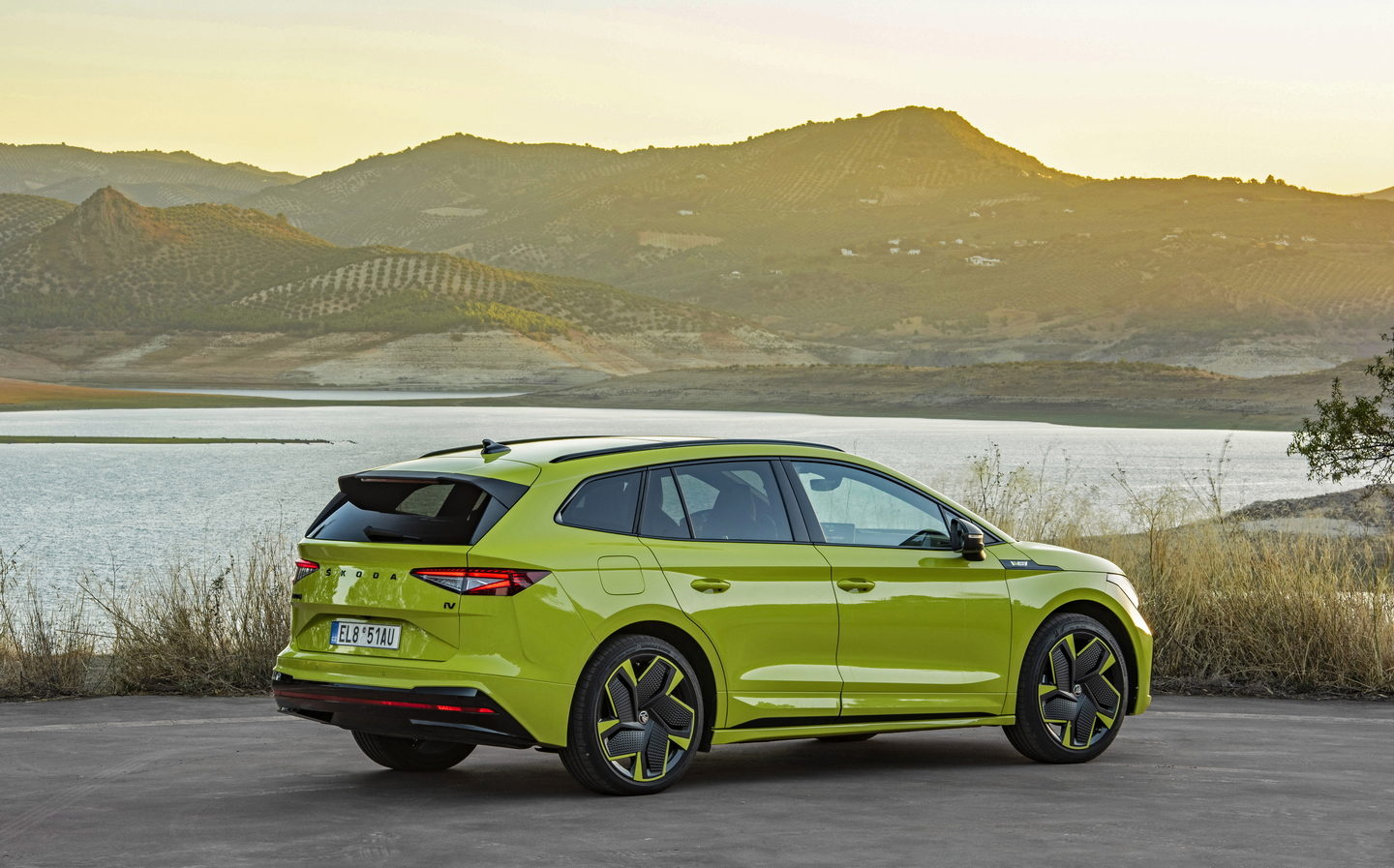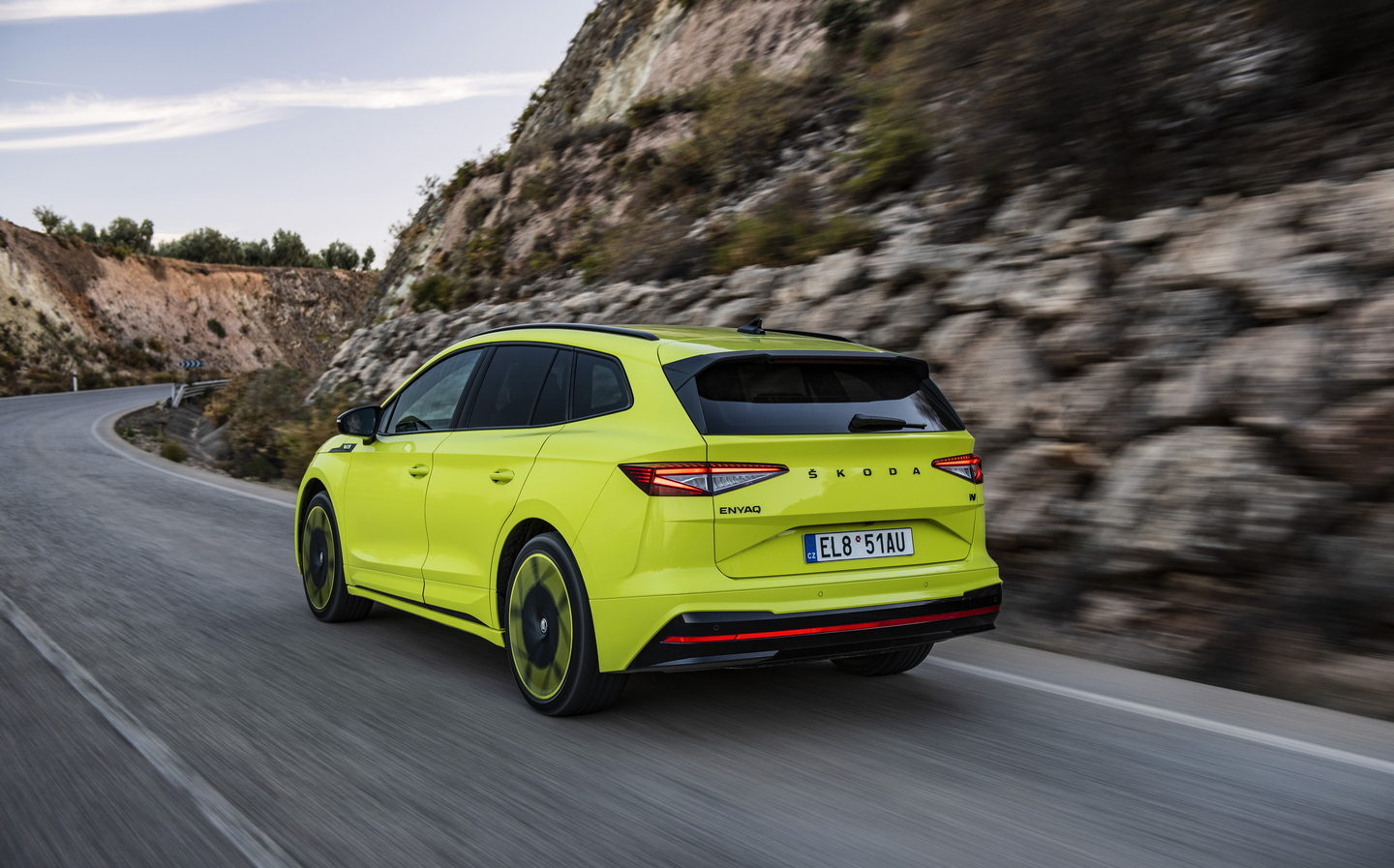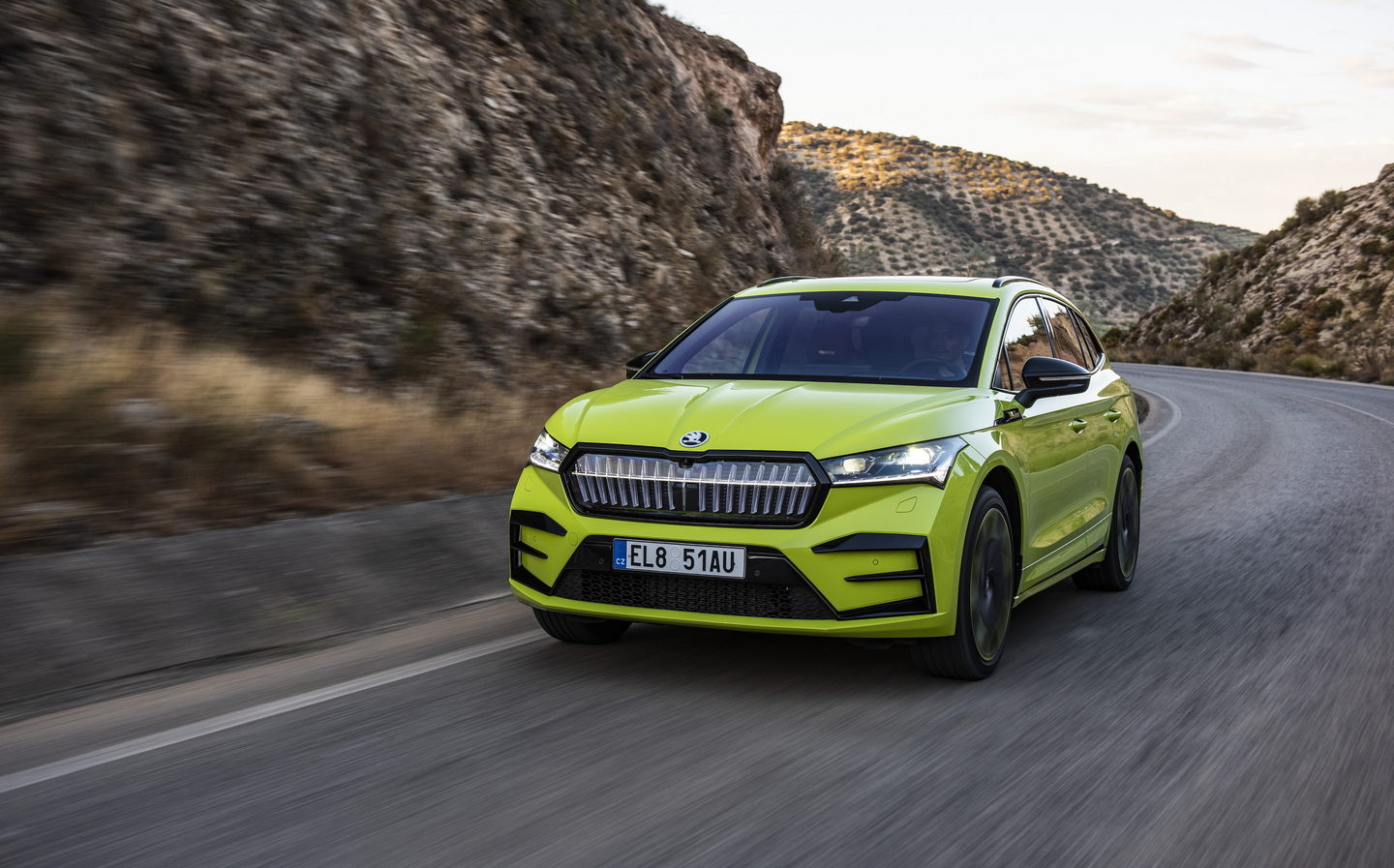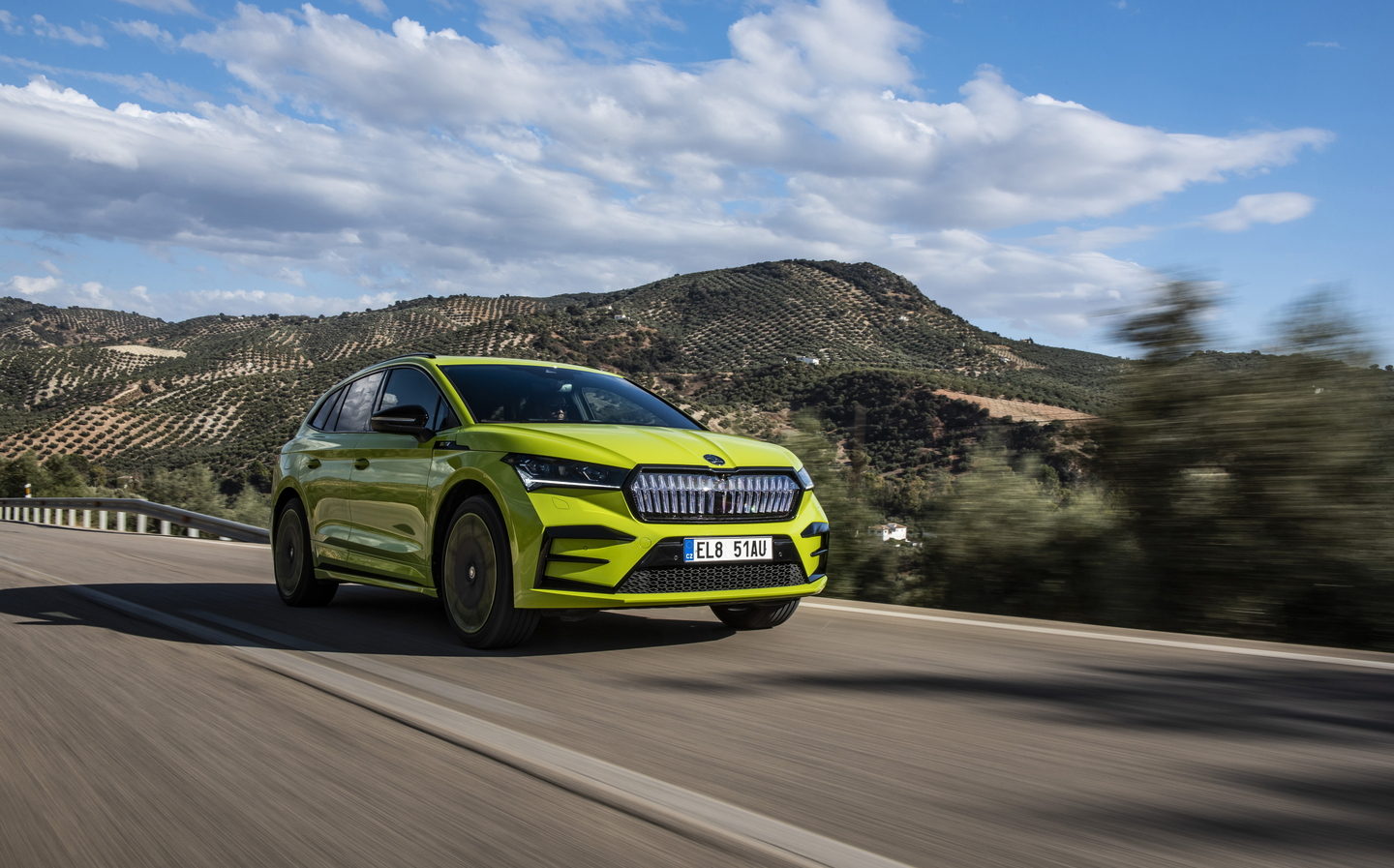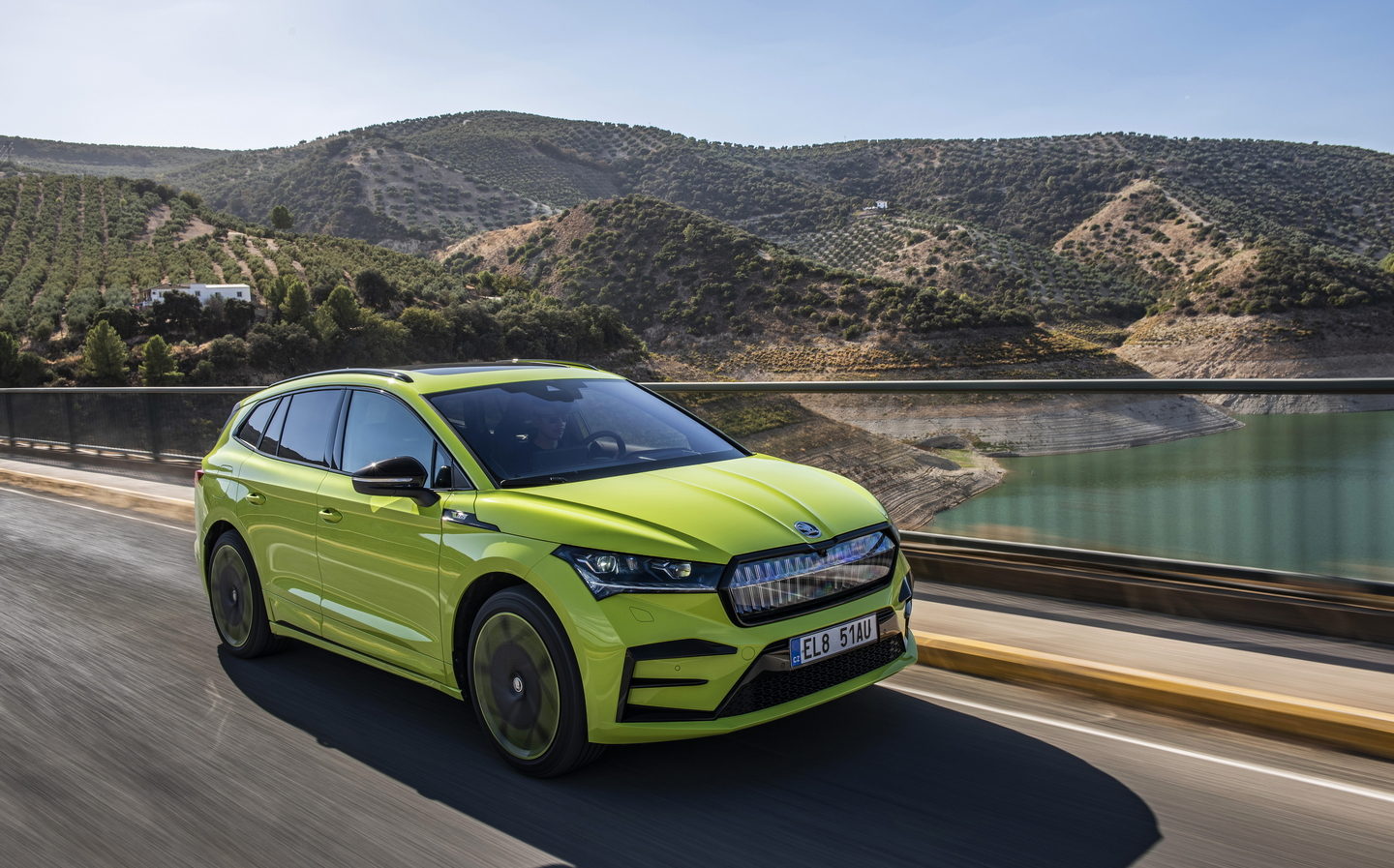Skoda Enyaq iV vRS 2023 review: The best sporty electric SUV for families?
Is it even a pretty face?
When Skoda launched the pure-electric Enyaq iV vRS with a fastback/ coupé bodystyle just a few months ago, it was no secret that a more traditionally-booted (and therefore more practical) sibling was also on the way. And we didn’t have to wait long for the more spacious car you see pictured here to arrive on the scene.
Like the vRS Coupé, it’s a more powerful version of the existing Enyaq iV, sacrificing a bit of range to provide a little more performance. But will it prove more convincing than its fastback-shaped relative?
Perhaps more importantly, does an electric SUV really deserve Skoda’s vRS badge, given the coveted combustion-powered models that preceded it, and is it really worth more than the already impressive Enyaq iV Sportline models that sit beneath it in the line-up?
Exterior design
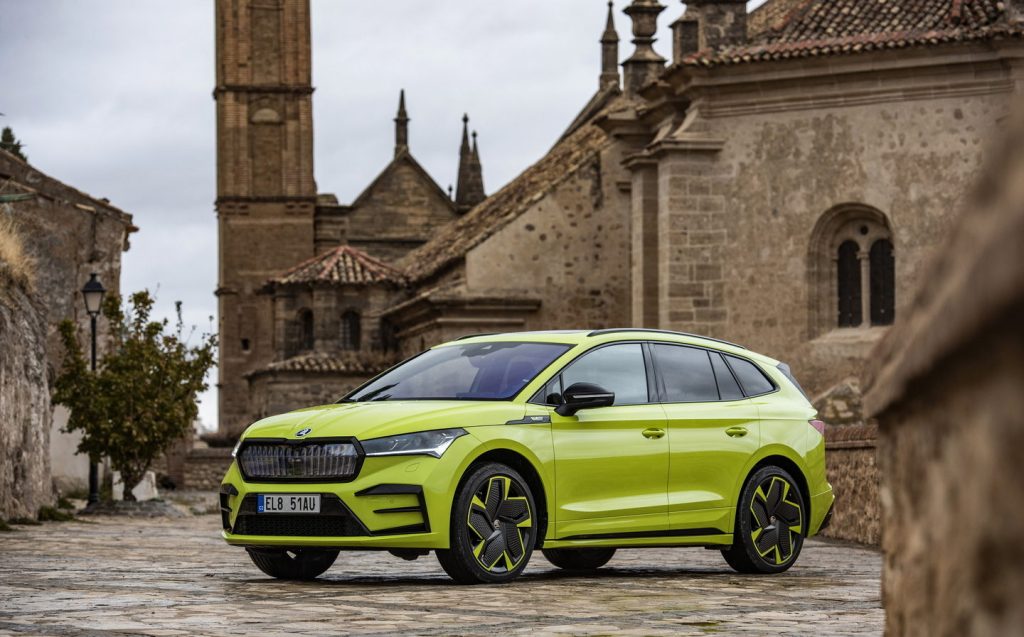
As with the vRS Coupé, Skoda has made a handful of modifications to this performance-orientated version of the Enyaq in a bid to differentiate it from its siblings. Key to this is the Crystal Face grille, which is the illuminated panel fitted to the nose of all vRS models as standard, whereas it’s an expensive option for the more conventional trim levels.
The grille splits opinion but there are more conventional sporty touches besides, such as the more aggressive bumpers and the wide side skirts. There’s gloss black trim, too, and the vRS gets 20in alloy wheels as standard, with 21in alloys available as an option. And because vRS models have sports suspension, they sits slightly lower than the standard Enyaq iVs.
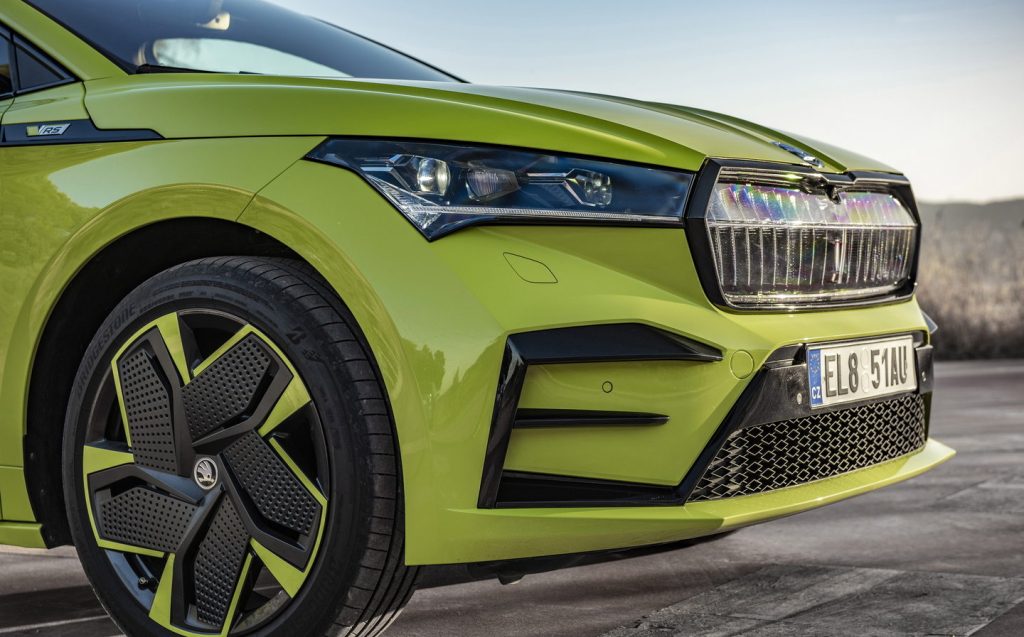
But as with the Volkswagen ID.4 GTX — a car with which the Enyaq vRS shares plenty — the Skoda’s design doesn’t go over the top. Unlike the Octavia vRS, the high-powered Enyaq only has vRS badges on the front wings, and there’s none on the boot. But there is a nod to the sporty saloon in that the Enyaq iV vRS does have a wide red reflector across its rear bumper.
There is a catch, however. Grille, badges and bumpers aside, the vRS’s visual upgrades are very similar to those of the slightly cheaper Sportline models, which are designed to sit between the high-performance vRS and the more conventional Enyaqs. Even the suspension set-up is the same, and you get similar 20in alloys and glossy black trim as standard.
Interior and practicality
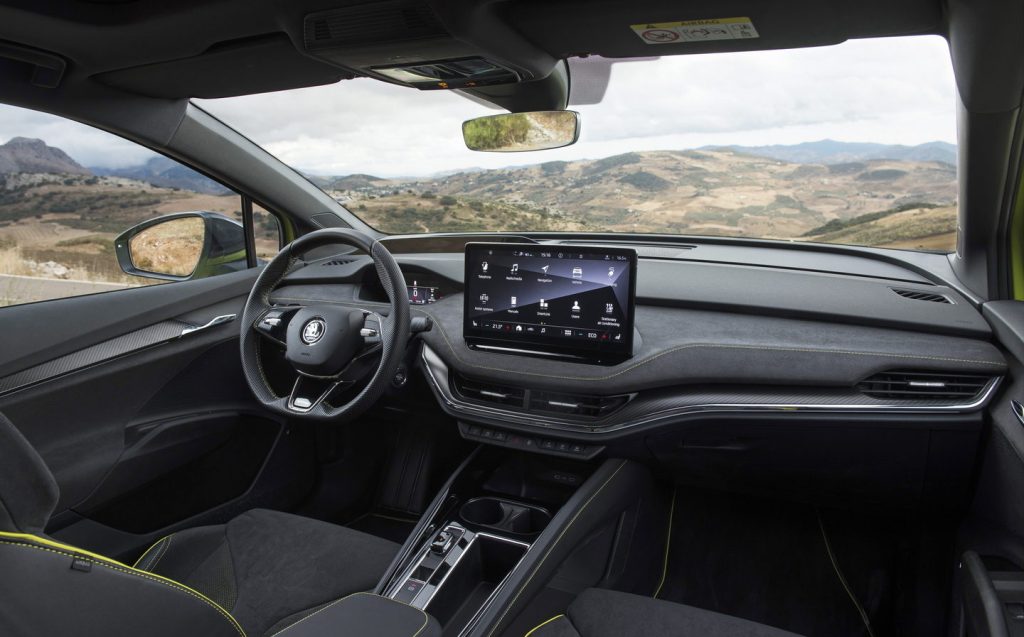
Unsurprisingly, the vRS’s cabin is much the same as that of the standard Enyaq, so you get the same dashboard dominated by a massive central touchscreen. That’s joined by the digital instrument display in front of the driver, while buttons are more or less limited to those on the steering wheel and centre console, plus a few on the dash.
As you’d expect from a modern Skoda, the quality is impressive, and everything feels solid. There are a few substandard plastics kicking about, but even they are well screwed together and the overall material quality is generally very good for something that supposedly sits beneath the closely related VW ID.4 and Audi Q4 e-tron SUVs. But none of that is especially remarkable for what’s meant to be a range-topping performance model.
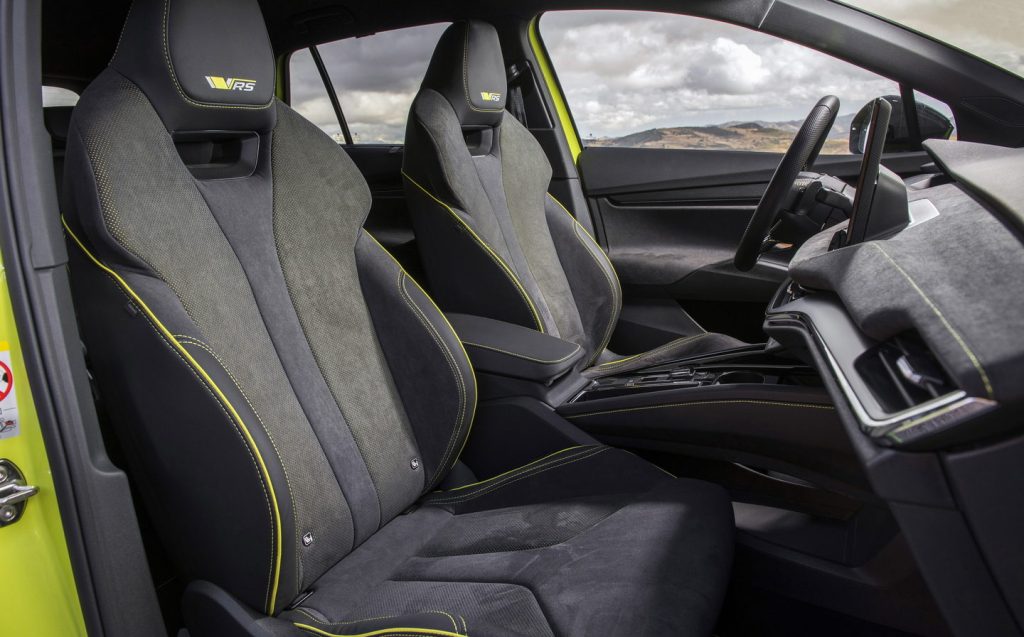
To help the car fit that bill the vRS has been given a few upgrades, and Skoda is offering a choice of two interior designs. There’s the vRS Lounge, which comes with suede dashboard trim and the same material — albeit flecked with green accents — on the sporty sculpted front seats. Carbon-effect decorative trim has also been fitted to the dash, while there’s black roof lining for a more motorsport-inspired look.
The other option is the vRS Suite version, which comes with many of the same features and swaps the suede upholstery for black perforated leather with grey piping and contrast stitching. There’s grey leather piping on the floor mats, too.
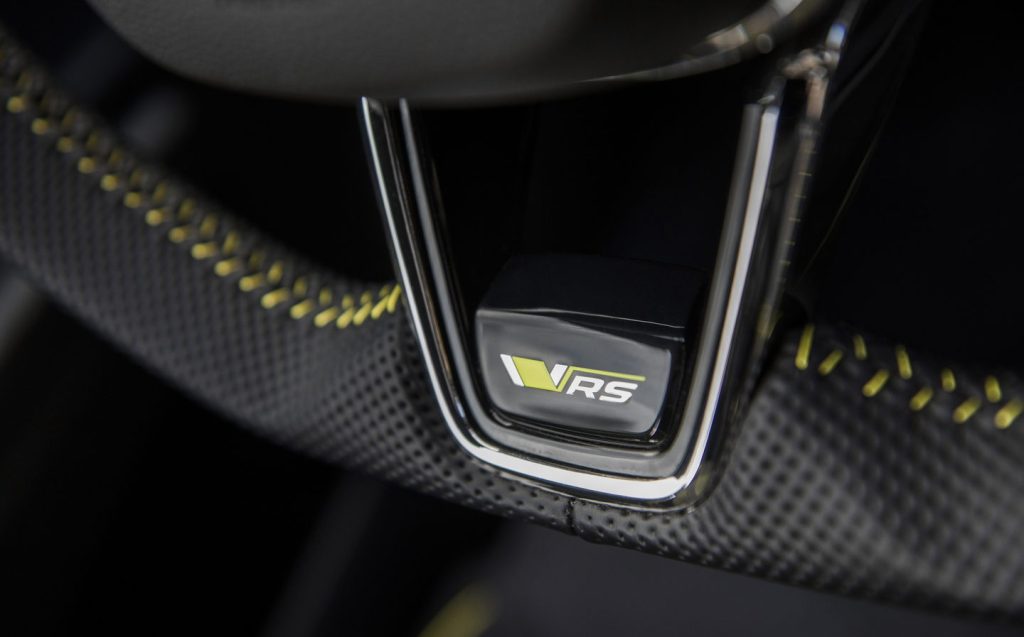
With such superficial changes, the move to vRS specification makes very little difference to the Enyaq’s strong practicality credentials.
In SUV form, the Enyaq vRS has the same massive 585-litre boot as other Enyaq SUV models, although that only drops to 570 litres if you pick the Coupé body shape. And while every Enyaq comes with acres of rear legroom, the SUV’s higher roofline means there’s more headroom than there is in the Coupé, and marginally squarer loads can be lugged.
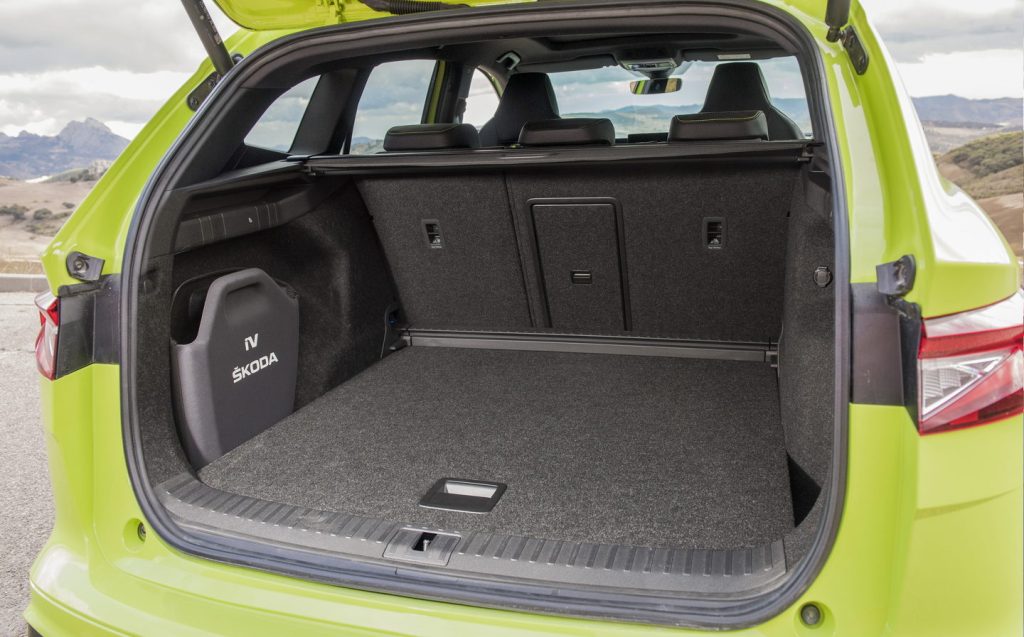
Technology and safety
Because the Enyaq vRS gets much the same equipment as more conventional Enyaq models, the technology is more or less unchanged. Sure, there are some clever vRS logos in the graphics on the touchscreen but otherwise it’s exactly the same.
Which is a mixed blessing, because while the huge screen is sharp and generally quick to respond, the latest-generation Skoda infotainment systems are flawed.
The touchscreen might look great but the menus are needlessly fiddly and important features are hidden deep in the bowels of the system.
Worse still, Skoda deemed the system good enough to make most of the conventional switchgear redundant. That means the screen houses a complicated climate control system and all the driver assistance tech. There isn’t even a volume knob – there’s a fiddly slider system instead. Fortunately there are steering wheels controls for the basic assistance and stereo systems.
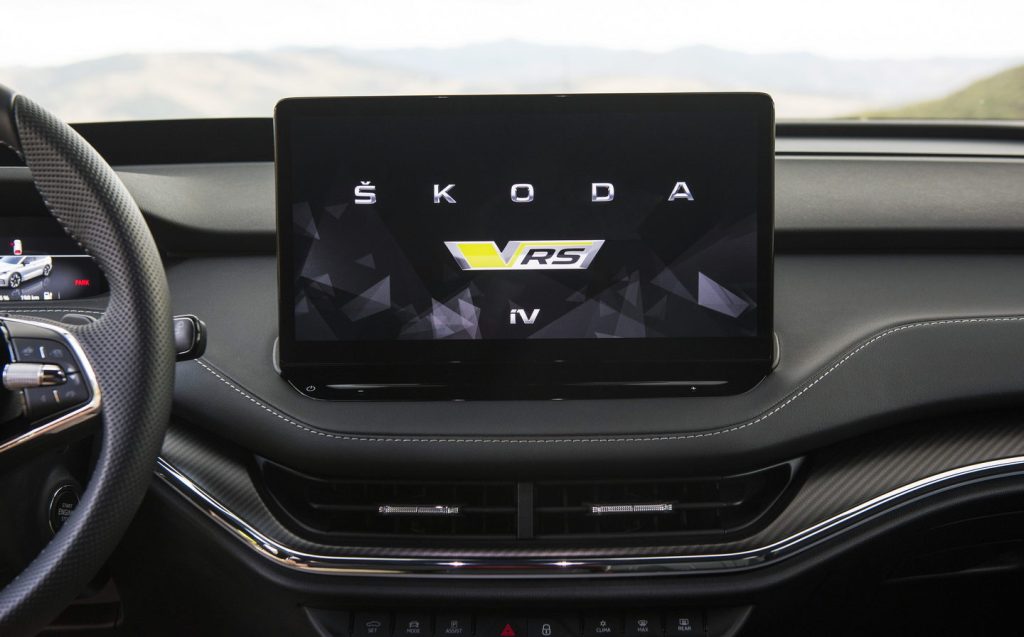
But while the touchscreen is not a triumph, the optional head-up display is much more like it. The display is projected onto the windscreen and it’s massive, offering augmented reality technology that can highlight vehicles the adaptive cruise control has picked out and the lines on the road when the lane departure warning system is activated.
That’s useful, because the other screen in the Enyaq’s cabin — the digital instrument display — is not Skoda’s finest effort. Whereas family cars such as the Superb and Octavia have massive, crisp and configurable displays, the Enyaq follows the VW electric car template and makes do with a smaller, more cluttered affair. It’s functional but feels a bit low-end alongside other Skoda cabins.
Performance, 0-62mph, electric range and charging times
The Enyaq iV vRS has the same pure-electric powertrain as the VW ID.4 GTX, which means there’s a 77kWh battery feeding two electric motors — one on each axle. That gives the vRS all-wheel drive and 295bhp, which is enough to take it from 0-62mph in 6.5 seconds.
That’s only a marginal increase compared with the 262bhp, all-wheel-drive Enyaq iV Sportline 80x model, which can also get from 0-62mph in less than seven seconds, but the vRS has an increased top speed. Instead of topping out at 99mph, as the Sportline will, the vRS can hit 112mph.
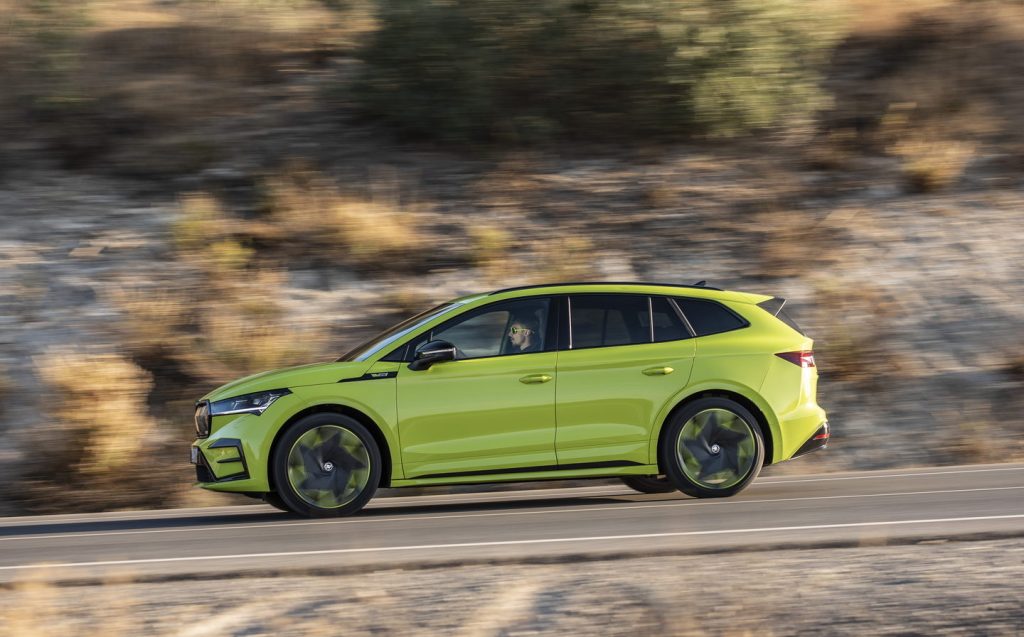
Few buyers will notice the difference — both the 80x and vRS models make rapid progress and feel very responsive — but they will spot the difference the driving modes make. While the vRS doesn’t feel especially punchy in Normal mode, it feels more alert when you switch to the Sport setting. Again, though, the same is true of the 80x.
But although the minimal differences in performance might not sound too impressive, they do at least mean the range doesn’t suffer. While an Enyaq 80x will do around 320 miles on a charge according to the official economy test, the vRS manages much the same feat. Of course, in the real world, both will struggle to top 300 miles, but there’s little to choose between the two.
For those who really want the maximum range, the ‘80’ model (as opposed to the 80x) is the one to go for. With only one motor and rear-wheel drive, the 80 versions go further on a charge, but they sacrifice a bit of power to achieve it.
And, strangely, buyers who stick to the SUV body shape rather than opting for the Coupé will reap the rewards in terms of range. The difference is only a handful of miles, but that’s the equivalent of an extra few per cent in the battery.
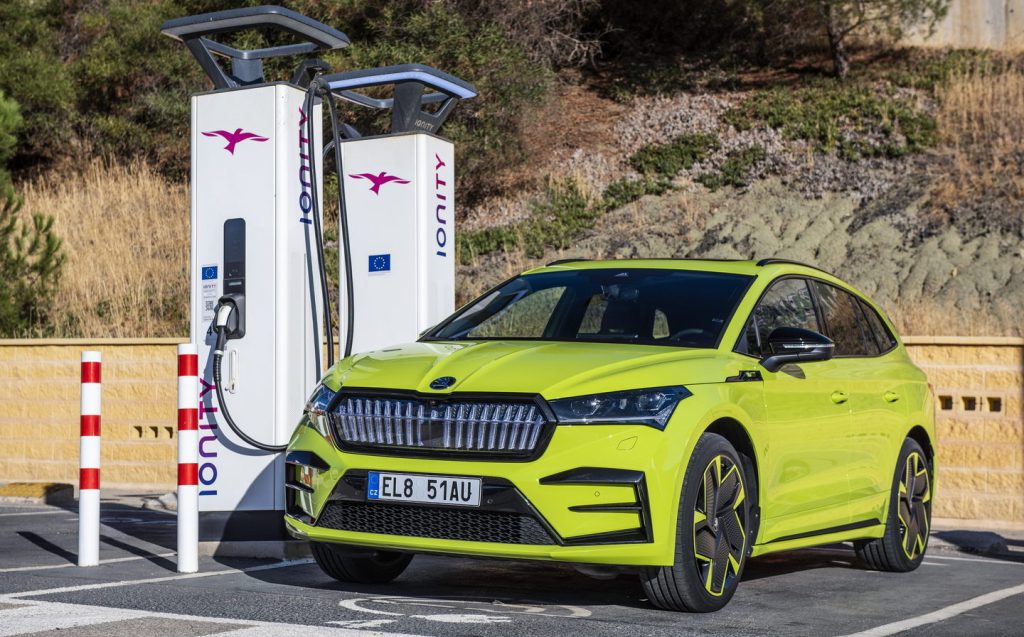
No matter which Enyaq you choose — vRS or otherwise — you get 135kW charging, allowing the car to take on charge more quickly. With the aid of an appropriate 150kW charging point, the vRS’s battery can be charged from 10 to 80 per cent in a little over half an hour, which makes it more usable over long distances.
Ride and handling
Despite supposedly being the sportiest model in the Enyaq stable, the vRS has the same sports suspension setup as the Sportline versions. That means the front end sits 15mm lower than that of a standard Enyaq, while the difference at the rear is 10mm. We’ve no quarrel with that – it works very well – but it does leave the vRS feeling remarkably similar to the Sportline on the road.
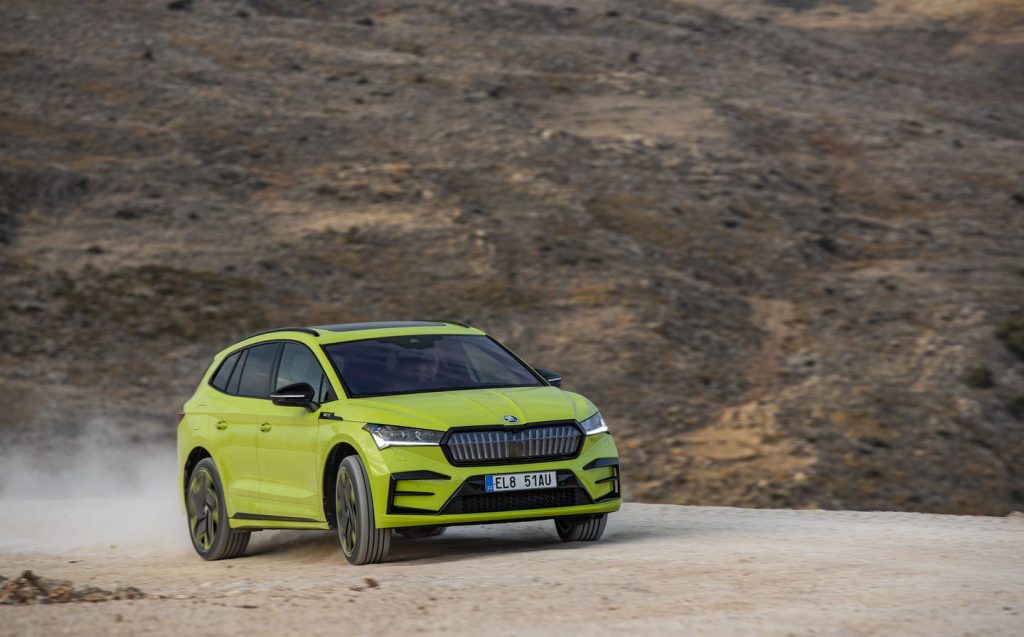
The vRS rides just as well as the Sportline, even on optional 21in alloy wheels, and it makes for a very comfortable motorway cruiser. That said, there is a little road noise depending on the surface, and the car does lose a bit of composure at lower speeds, where the weight of the battery seems to compromise the ride over sharp bumps such as potholes. Overall, though, it rides very well despite its sporty credentials.
At the same time, the suspension manages to provide solid body control that prevents the Enyaq from rolling too much in corners. There’s a bit of lean, but it’s kept in check reasonably well for such a high-riding car. The steering is light and a little on the numb side, but it’s better than that of most family SUVs these days, so like the Sportline, the vRS allows you to have a little fun when the mood takes you.
Skoda offers the optional Dynamic Chassis Control system on the vRS, which will add a Comfort mode to the existing driving modes — not that the Enyaq really needs it.
More to the point, it will give drivers the chance to tune their car’s suspension, throttle response and steering even more than the standard driving modes permit.
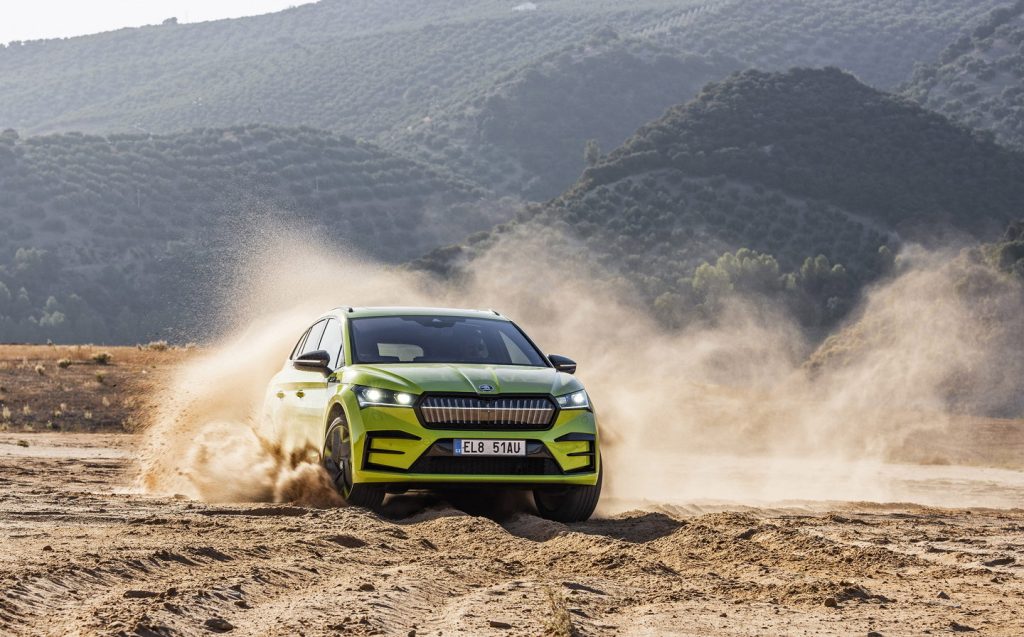
Whether you choose that system or not, the all-wheel-drive system and ground clearance of all vRS models mean they also have a modicum of off-road capability — even with the lowered suspension. It’ll cope with anything most customers are likely to throw at it, and it has a clever driving mode for maximum traction on slippery surfaces.
But whereas the high-performance GTX model is the only all-wheel-drive option for VW ID.4 customers, the vRS is one of two dual-motor options in the Enyaq range, so that all-terrain capability is less of a boon than it might otherwise be.
Prices, rivals and on-sale date
The Enyaq iV vRS comes in at £52,670, which makes it less than £1,000 more expensive than the Sportline 80x and £1,700 cheaper than the vRS Coupé. To a degree, the price reflects the lack of differentiation between the vRS and the Sportline 80x, both of which get similar equipment. Heated seats, a manoeuvring camera and a heated steering wheel are all included, along with the digital instrument display and the huge touchscreen.

Of course, the vRS comes with its own styling features, including the carbon-effect trim on the dash and the green ambient lighting, but the big difference is the grille. That Crystal Face, which costs hundreds to replace if it goes wrong or gets broken, is an option for Sportline models, coming as part of a pack that costs more than £2,000. If you want the Crystal Face, the vRS model might well be the cheapest way of getting it.
Depending on how you cut it, there are now plenty of rivals to the Skoda Enyaq iV vRS. Aside from the ID.4 GTX and ID.5 GTX there’s the Ford Mustang Mach-E, though in dual motor form it is much quicker and pricier, the Volvo XC40 Recharge Twin, Tesla Model Y, BMW iX3 and Audi Q4 e-tron.
If you have a fair bit more wedge (as in around £70,000), there’s the Mercedes EQC, Jaguar iPace, BMW iX and Audi e-tron, which are also a bit quicker than the Skoda, rather making the idea that the Enyaq iV vRS is a truly quick car seem a bit silly.
Less performance-oriented but still quick electric rivals include the Nissan Ariya and Renault Megane E-Tech.
Verdict: 2023 Skoda Enyaq iV vRS review
There’s no doubt the Enyaq iV vRS has managed to capture the essence of the Coupé version and apply it to the standard SUV, and in that respect it’s a great success. But somewhat ridiculously, the differentiator between the vRS and Sportline models is the Crystal Face grille. It’s an expensive option for Sportline customers, so those who want the LEDs on the nose can save a few quid by simply opting for the vRS.
Those who prefer the more conventional look will miss very little by sticking with the cheaper Sportline.
And while it has the vRS badge, this Enyaq isn’t much quicker or sportier than most other electric SUVs out there, and in some cases slower. Think of it more as a sharpened up family hauler, though, and it is a pleasing thing to own and drive.
Related articles
- After reading our review of the Skoda Enyaq iV vRS, you might want to see our review of the Volkswagen ID. Buzz
- Here are all the car makers’ electric car plans
- Read our review of the Renault Mégane E-Tech Electric
Latest articles
- Should I buy a diesel car in 2025?
- F1 2025 calendar and race reports: The new Formula One season as it happens
- Zeekr 7X AWD 2025 review: A fast, spacious and high tech premium SUV — but someone call the chassis chief
- Denza Z9GT 2025 review: Flawed but sleek 1,062bhp shooting brake from BYD’s luxury arm
- Extended test: 2024 Renault Scenic E-Tech review
- Best-selling cars 2025: The UK’s ten most popular models of the year so far
- Audi A6 Avant 2025 review: Trusty executive estate ticks expected boxes, and there’s still a diesel option
- Keir Starmer eases pressure on carmakers to sell EVs in response to ‘global economic headwinds’
- Ferrari 12Cilindri Spider review: Heady blend of traditional and futuristic becomes even more intoxicating after lid is removed


